

6 Interesting Customer Service Case Studies to Inspire You
July 18, 2023
Share This Article:
An 11-year-old boy’s experience with LEGO customer service changed the company’s brand perception. It’s not only brought in more customers but also justified their lead position in the market. Here, we will discuss a few more interesting customer service case studies.
One good service can not just help one customer but also influence future customers. Reading others’ stories will help you understand ways to overcome new challenges.
I will start with some popular ones.
Popular customer experience case studies
Customer service is not just limited to providing product-related support anymore. We have passed the line way back. As the market gets more critical, everyone is running a few extra miles. Even the top companies in the field are not compromising anything.
Let’s start with JetBlue’s customer service case study.
JetBlue sets an example of how you can use social media to provide excellent customer service. They have multiple teams at different levels that are active on Twitter. And there are many examples of it.
Here is one: Paul once tweeted that he couldn’t find Starbucks at the gate while boarding the flight. JetBlue immediately responded with an alternative, which was free for him.
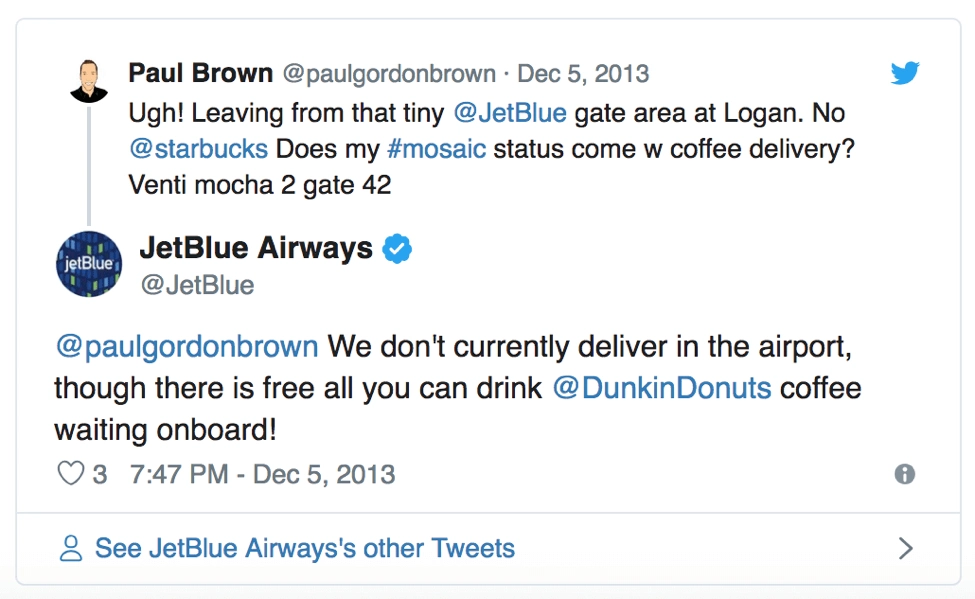
Another challenge that JetBlue faced was the winter storm in early January of 2017 . They had to cancel a lot of flights at that time. And because of this, thousands of people were impacted.
The challenge here is that JetBlue cannot change the weather or ensure a safe flight during a storm. But they can provide up-to-date information.
So, they started to tweet updates about the storm and the flight schedule the whole time. As a result, even though the passengers were frustrated, they were happy with JetBlue’s service.
Zappos has a good reputation for providing the best customer support. And it has a lot of interesting customer service case studies. One particular service case created a lot of buzz in the market.
Zappos’s service agent talked with a customer for 10 hours in one call. And, surprisingly, Zappos took it in a positive way. The call wasn’t even about any service.
This long call started with where and how that customer lives. Then, eventually, it turns into clothing and fashion-related conversation. Finally, the customer ended the call with the purchase of a pair of UGG boots.
It breaks all the records and wins a long-running battle. Which one is better, automated calls or live agents? And without a doubt, it’s the personal touch that steals the crown every time.
This customer service case study is a bit more heartwarming. 11-year-old James Groccia has Asperger’s syndrome. He was looking at an expensive LEGO set for his birthday. It’s the exclusive Emerald Night Train set.
James saved money for two years. The money came from his birthday gifts and his participation in research. But he was heartbroken when he found out that it was unavailable.
His mother looked everywhere possible. On Amazon, eBay, or any other platform, it was either out of stock or too expensive. Eventually, with the help of a social worker, James wrote to LEGO.
It was a huge surprise to James that LEGO wrote back. And not just that, they surprised him with the exclusive Emerald Night Train set just before his 11th birthday.

It wasn’t easy for LEGO as well. It was a discontinued set and a collectible. They had to track it down for him. This extra mile not only made that customer happy but also established a brand perception that cares about its customers.
WPManageNinja’s customer service case study
While we were looking for customer experience stories, we talked with our Support team head, Mr. Kamrul Islam , here at the WPManageNinja office. He shared a few interesting case studies with us.
“I made a full website using your table builder plugin.”
Our support team faces and solves a lot of interesting cases every day. So, from a lot of stories, we have chosen three interesting stories to share with you in this blog. And, we are not going to be technical here at all.
So keep reading.
Story #1: Fluent Form
Let’s start with a simple one. One of our clients creates a ticket with an issue through our Fluent Support helpdesk system .
Ticket created from customer’s end
I am a Fluent Form user. And I want to create a booking form using your form builder.
Thanks a lot for contacting us. Let us get into it and see what we can do for you. We will get back to you ASAP.
Booking system plugins are typically used for appointment booking. However, our support team needs to find a way to use our form builder plugin to accomplish this task.
But instead of saying, “This is not possible,” to our client, they get to work. Started figuring out a workaround for this. For obvious reasons, a form builder cannot provide a booking system facility, but the team finds a way to use it as a basic date booking system.
Our support team used two date-picker blocks from our Fluent Form builder and used different blocks to pick the starting and ending dates. Our team got in touch with the customer and gave him the solution.
But the customer knocked again.
Ticket continue
I am happy with the solution, but I’m facing an issue. I picked one date from the “Start from” calendar drop-down, but I can still see the previous dates are active in the “End at” drop-down. I want it disabled.
Here is a screenshot.
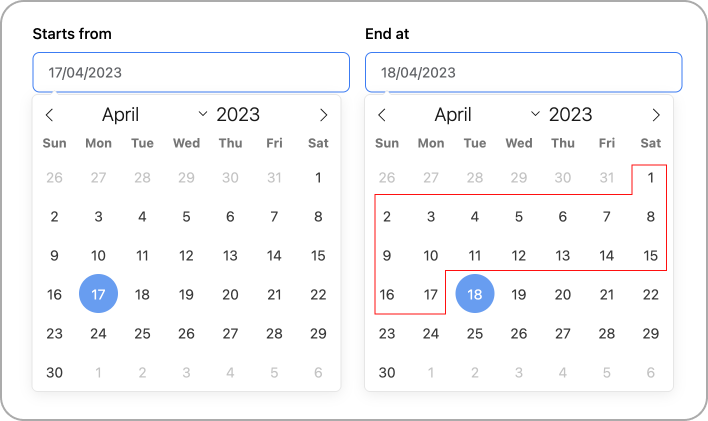
We can certainly help you out with this. We will get back to you shortly with a solution. We really appreciate your patience, and thanks a lot for being with us.
As our support specialist stated, they provided a solid solution. They had to write some custom code to implement a new feature in the client’s system.

That customer not only gave us a 5-star rating for our service but also became one of our loyal customers.
Story #2: Ninja Table and Fluent Form:
Speaking of adding custom features, it’s one of the regular jobs for our support team. Support agents, from time to time, write custom codes to fulfill customer requests.
Once, we got another ticket about a dynamic integration between two of our products. And the request came in multiple layers.
Hi, I am ruining a multi-user-based site, and recently I purchased the Ninja table for my site. I bought this to list my users information in a single table. But after a few tries, I failed to do it. Can you help me?
Thanks a lot for connecting us. We can help you with your issue. We will get back to you ASAP with a solution. Thanks a lot for being with us.
Our support agent needed to create a table from the site’s SQL data that contained user information.
It was an easy fix. Ninja Table has that feature built-in. Our expert agent wrote a few lines of script to pull users’ information. It created a table from SQL data.
The tickets continue.
Now I can see all the users’ information in a single table. But now I want to display only logged-in user information in the table. The rest of the user’s information should be hidden for that user.
Sure, we can do that for you.
So, the support agent created a custom shortcode to embed the table on the display page. That custom shortcode restricted other users’ information to the logged-in user.
But the client came to our support team again.
Hi, I’m very happy with the output. But now I need one more thing from you. I need another column in the table with a form link in it. If a customer clicks on it, it will open a new page with the form on it. And I need it to be prefilled with the information from the table. I don’t want my customer to fill out the form again.
We can certainly help you with this. Our engineers will get into it and get back to you soon with a solution.
Our support team has two challenges in solving this ticket.
- A table created using SQL data has a limitation. You cannot add a new column to the table without touching the SQL data. Altering SQL data is not a good idea at all. So, adding a new column in the table with a form link is difficult.
- Pull the data from the table to prefill a form with logged-in users data. And then make the prefilled input box uneditable.
Our team starts with the first challenge. We cannot create a new column without altering the SQL data. But then they figured out a way to replace particular data with the desired data. And in this case, the desired data is the form page link.
So, they used a column from the SQL data set that did not have important information. Using the custom scripting, they replaced the SQL-pushed data with the form page link. Part one is solved.
For the second challenge, our team used Fluent Form. They integrate the Fluent form with the Ninja table. With the help of some custom scripting, they were able to pull the data from the table into the form’s input box.
The client was really happy with the outcome. Just because of this service, the client bought all of our products. And there is no need to mention that the client became one of our advocates.
Story #3: Ninja Table
Customers can show you totally different use cases for your product. This particular story is the best example of this statement.
Hi, I am using your Ninja Table plugin on my site. I need to link a Google Sheet with the plugin. Is it possible?
Thanks a lot for connecting us. We have a built-in integration facility for Google Sheets in the table settings.
At this point, the WP Manage Ninja team sent a step-by-step video tutorial to show how to do the integration. and the client was happy with this.
But shortly after that, clients connected with our support team again with multiple queries.
I need your help to customize the table. I want to make it look different from a regular table. Specifically, I want to hide the header and border and resize the columns and rows. I also want to know if I can apply custom styling to the data from the Google Sheet and if an image inserted in the Google Sheet will appear in the table. So somehow, I don’t want it to look like a table.
Thanks again for connecting with us. All of your requests are possible. However, it would be helpful if we could have access to the site table on your site. This would allow us to provide you with a better suggestion.
The client shared a link to the site with the support team. The whole team was a bit confused.

Hi again. Thanks a lot for sharing the site link with us. But we may need a little more information about the site. And please specify where you want to put the final table. Also, can you please give us a link to the actual table?
I gave you the link to the table.
We are very sorry; you just gave us a site link. We cannot see any tables here.
That is the table.
May you please elaborate? What do you mean by that?
I made a full website using your table builder plugin.
After some inspection of the site, our agent realized our client had made a fully functional website using our table builder plugin. We were just amazed by this type of use case.
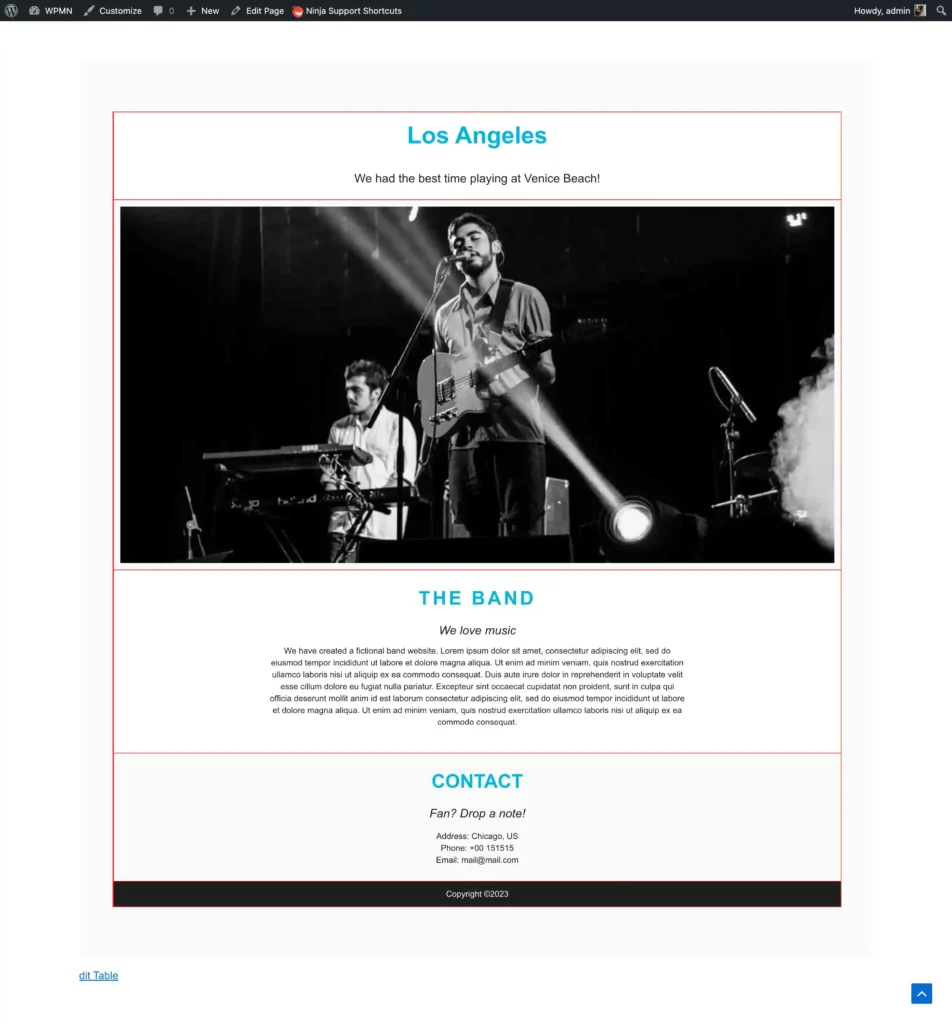
The client also linked the table with a Google Sheet, which we helped them with previously. This means that they do not need to log in to the WordPress dashboard to change any data.
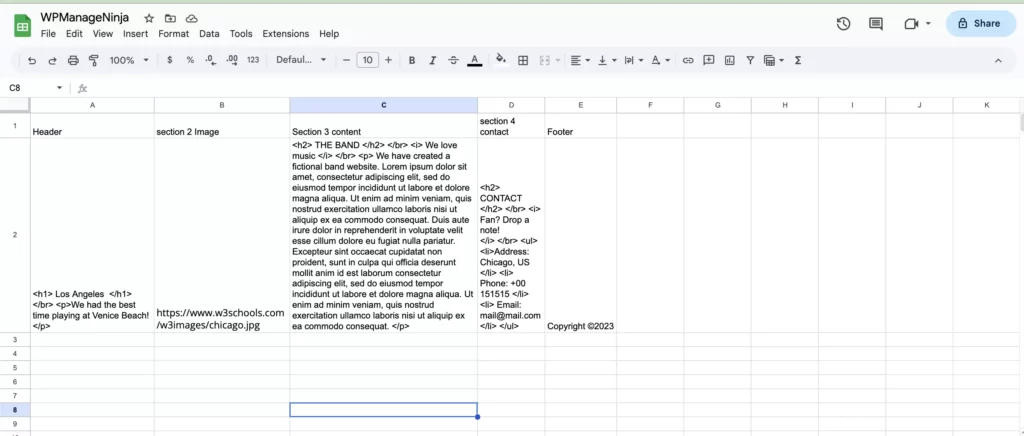
The client can simply make changes to the Google Sheet from their phone, and our table plugin will automatically update the data on the site.
This is so far one of the most unique and clever use cases we have seen for any of our products.
Takeaways customer service case studies
Up until now, we have shared six different customer service case studies. But these are not just stories. These case studies tell us what excellent service is. It teaches us how we can go the extra mile and how it can impact our customers.
Essential qualities of the best customer service reps
So, here are a few takeaways from these case studies:
- Be responsive. Respond to the customer, even if it’s a tweet. Be quick and efficient.
- Be helpful. Go above and beyond to help customers. This could mean tracking down a discontinued product, giving a refund, or even just sending a handwritten note. Personalization matters in customer relations. A good gesture could be to send customers gratitude notes that have been carefully crafted to suit their tastes. You can design cards , for instance, which gives you ample room for creativity and personal touch. Even when they don’t know it’s not required. This could mean offering advice, making recommendations, or just listening.
- Be transparent. Be honest with customers, even when it’s not good news. Customers always appreciate a direct response, even when they are angry.
- Be personal. Take the time to get to know the customer’s individual needs. This will help you provide more personalized service. Which will make them feel special.
- Be human. Don’t hold your personality back; let your human side shine through. Show that you care about the customer and their experience. This could mean using humor, being empathetic, or just being yourself. The personal level of connection is effortless. This will make your service seamless.
- Go the extra mile. Go above and beyond to help customers. This could mean tracking down a discontinued product, giving a refund, or even just sending a handwritten note. Whether you need to write custom code, provide training, or even just be a sounding board, let it be.
- Be creative. If you can’t find a solution, that’s fine. Go out of the box and come up with a new one.
- Be patient. Sometimes, it takes time to find the right solution that works. Be patient with customers and stay with them until they’re happy with it.
- Be open-minded. Customers may use your product in ways that you never intended. Be open to new ideas.
- Be impressed. Be amazed by the imagination and creativity of your clients. When you see customers using your product in a unique way, make sure to let them know how impressed you are.
Final thoughts
Being a tech support specialist or service agent is a challenging job, no doubt. A customer can come up with any type of issue. Hance, the service providers have to be sound enough to deal with any surprises.
The service-dependent industries are constantly facing a variety of cases every day. That’s why customer service case studies are a must-read for support and service providers. And, on the other hand, these stories can bring in new customers.
Start off with a powerful ticketing system that delivers smooth collaboration right out of the box.
Md. Ariful Basher
Hi, this is Abir, a product marketing strategist, passionate product designer, and WordPress core contributor. Creating interesting content and products that ensure a 360-degree customer experience is my daily job.
Related Articles

25+ ways Increase Service Agent Productivity

How To Fix “SSL_ERROR_NO_CYPHER_OVERLAP” Error
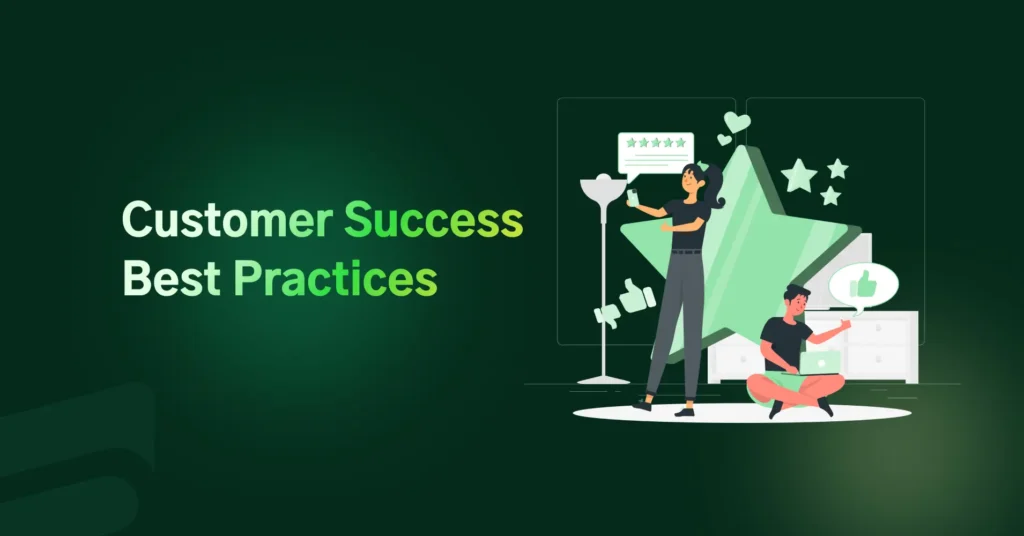
10 Customer Success Best Practices to Follow in 2024

What makes WordPress free (and what doesn’t!)

How to Fix “Your Connection is Not Private” Error

The 5 Best Portfolio Website Builders for 2024
Leave a reply cancel reply.
Your email address will not be published. Required fields are marked *
Save my name, email, and website in this browser for the next time I comment.

Customer Service Case Studies: Real-Life Examples Of Service Scenarios.
Are you looking for real-life examples of customer service scenarios that can help you improve your own customer service skills? Look no further!
In this article, we will explore a series of case studies that highlight different aspects of effective customer service. These case studies will provide you with valuable insights into how to handle challenging situations, resolve issues, and create positive experiences for your customers.
Customer service plays a crucial role in the success of any business. It is not just about answering phone calls or responding to emails; it is about building relationships and exceeding customer expectations. By studying real-life examples, you can gain a deeper understanding of the importance of effective customer service and learn strategies to enhance your own skills.
In each case study, we will delve into different scenarios and examine how businesses successfully handled them. From resolving product quality issues to dealing with difficult customers, these case studies will showcase various approaches and solutions that you can apply in your own work.
Get ready to dive into these insightful stories that demonstrate the power of exceptional customer service!
Table of Contents
Key Takeaways
- Effective customer service is crucial for the success of a business.
- Empathy and proactive customer service are essential aspects of providing excellent customer service.
- Prompt resolution of product quality issues, with notification and compensation for affected customers, helps maintain customer satisfaction and loyalty.
- Handling difficult customers with a calm and empathetic approach, offering alternatives, and empowering them to make choices can build trust and loyalty.
The Importance of Effective Customer Service
You can’t underestimate the impact of great customer service – it’s like a warm cup of coffee on a chilly morning, instantly making you feel valued and appreciated.
In today’s competitive business landscape, providing effective customer service is more important than ever. Customers have numerous options at their fingertips, and one bad experience can send them running to your competitors. That’s why empathy plays a crucial role in customer service.
When customers feel understood and cared for, they’re more likely to become loyal advocates for your brand. Empathy is the ability to understand and share the feelings of others. In customer service, this means putting yourself in the shoes of your customers and genuinely listening to their concerns.
By showing empathy, you demonstrate that you value their emotions and are committed to finding a solution that meets their needs. This not only helps resolve issues effectively but also builds trust and strengthens the relationship with your customers.
Proactive customer service is another essential aspect of providing exceptional support. Instead of waiting for customers to come to you with problems or complaints, proactive customer service involves anticipating their needs and addressing any potential issues before they arise.
This approach shows that you’re dedicated to delivering an outstanding experience from start to finish. By taking the initiative, you can prevent problems from escalating and create positive interactions that leave a lasting impression on your customers.
The importance of effective customer service cannot be overstated. Empathy allows you to connect with your customers on a deeper level by understanding their emotions and concerns. Proactive customer service demonstrates your commitment to going above and beyond expectations by anticipating needs before they become problems.
By prioritizing these aspects in your approach to customer service, you can foster loyalty, build strong relationships with customers, and ultimately drive success for your business.
Case Study 1: Resolving a Product Quality Issue
Resolving a product quality issue can be challenging, but did you know that 86% of customers are more likely to repurchase from a company that resolves their complaint? When faced with a product quality issue, it’s important for companies to take immediate action and address the problem effectively.
One notable case study involves a product recall due to safety concerns. The company promptly notified customers about the recall through multiple channels such as email, social media, and website announcements. This proactive approach not only ensured customer safety but also demonstrated the company’s commitment to resolving the issue.
To further enhance customer satisfaction during this challenging time, the company offered compensation to affected customers. The compensation included a full refund for the recalled product as well as additional discounts on future purchases. By going above and beyond in compensating their customers, the company not only mitigated any potential negative feelings but also showed genuine concern for their customers’ wellbeing.
In addition to addressing individual complaints, the company took steps towards preventing similar issues in the future. They implemented stricter quality control measures throughout their production process and conducted thorough inspections before releasing any products into the market. This proactive approach reassured customers that their concerns were taken seriously and instilled confidence in the brand’s commitment to delivering high-quality products.
By resolving a product quality issue promptly and ensuring customer satisfaction through compensation and preventive measures, companies can not only retain existing customers but also build trust with new ones. It’s crucial for businesses to recognize that effective customer service goes beyond simply resolving complaints; it requires taking responsibility for failures, implementing meaningful solutions, and continuously improving processes to prevent similar issues from arising again in the future.
Case Study 2: Handling a Difficult Customer
Navigating through challenging interactions with clients can be a test of your company’s ability to handle difficult situations. Dealing with angry customers requires a delicate balance of empathy, patience, and problem-solving skills.
One real-life example of a company successfully managing a difficult situation involved an irate customer who had received a damaged product.
In this case, the customer contacted the company’s customer service department immediately after receiving the damaged product. The representative on the phone remained calm and empathetic throughout the conversation, acknowledging the customer’s frustration. They apologized sincerely for any inconvenience caused and assured the customer that they would resolve the issue promptly.
The representative then offered several options to address the problem, including sending a replacement or providing a refund. By presenting these alternatives, they empowered the customer to choose what solution best suited their needs. This approach helped defuse tension and created an atmosphere of collaboration rather than confrontation.
Ultimately, by effectively managing this difficult situation and prioritizing customer satisfaction, the company not only resolved the issue but also built trust and loyalty with their client base.
Case Study 3: Going Above and Beyond for a Customer
Exceeding expectations and leaving a lasting impression, one company went the extra mile to ensure a memorable experience for a dissatisfied client. The customer, let’s call her Sarah, had purchased a high-end laptop from this company but encountered numerous technical issues soon after receiving it. Frustrated with the product’s performance and the lack of support she received initially, Sarah reached out to the company’s customer service department for assistance.
To address Sarah’s concerns promptly, the customer service representative assigned to her case took immediate action. Recognizing that resolving her technical issues alone would not suffice in restoring Sarah’s trust and satisfaction, they decided to go above and beyond what was expected. The representative personally followed up with Sarah daily to provide updates on their progress in fixing her laptop. They also offered additional compensation for the inconvenience caused by sending her a complimentary accessory package.
In addition to their exceptional level of communication, this company created a personalized experience for Sarah through small gestures that left an indelible mark on her overall perception of their brand. One example was when they surprised her by upgrading her laptop’s warranty without any additional cost. This unexpected act not only demonstrated their commitment to providing quality products but also highlighted their dedication towards ensuring customer satisfaction.
By going above and beyond in addressing Sarah’s concerns and surpassing her expectations at every turn, this company exemplified outstanding customer service. Their proactive approach not only resolved technical issues efficiently but also left a lasting impression on Sarah concerning how much they valued her as a loyal customer. Through personalized attention, generous compensation, and unexpected upgrades, they not only ensured Sarah’s satisfaction but also fostered a long-term relationship based on trust and loyalty. This case study serves as a powerful reminder that going the extra mile can make all the difference in customer satisfaction and retention.
Case Study 4: Turning a Negative Review into a Positive Experience
If your business has ever received negative feedback, it’s important to know how to turn that experience into a positive one.
In this case study, we will explore how a business addressed a customer’s concerns and transformed their perception from negative to positive.
By taking the necessary steps and going above and beyond, the business not only resolved the issue but also improved their reputation in the process.
The negative feedback received by the business
Despite your best efforts, your business was bombarded with a barrage of scathing feedback that left you reeling. Customers expressed their dissatisfaction with the quality of your products and the poor customer service they received.
These negative reviews not only affected customer retention but also posed a threat to your brand reputation. The negative feedback highlighted areas where improvements were needed. It pointed out flaws in your product design, manufacturing processes, and communication channels.
While it may be disheartening to receive such criticism, it presents an opportunity for you to address these issues and enhance the overall customer experience. By acknowledging the shortcomings and taking immediate action to rectify them, you can regain customers’ trust and loyalty while rebuilding your brand’s reputation.
The steps taken to address the customer’s concerns
After receiving the negative feedback, we quickly took action to address the customer’s concerns and improve our products and services. We understand that addressing customer complaints is essential for maintaining a positive reputation and ensuring customer satisfaction.
Our first step was to reach out to the customer directly, expressing our apologies for any inconvenience caused and assuring them that their concerns were being taken seriously.
To resolve the customer’s issues, we implemented a thorough investigation into the matter. This involved examining the specific details of their complaint, evaluating our internal processes, and identifying any areas where improvements could be made. By conducting this analysis, we were able to pinpoint the root cause of the problem and develop an effective solution.
Once we identified areas for improvement, we promptly made necessary changes to prevent similar issues from occurring in the future. This included updating our training programs for staff members involved in customer service interactions and enhancing quality control measures throughout our production process. We also communicated these updates transparently with all relevant stakeholders to ensure everyone understood our commitment to resolving customer issues.
Addressing customer complaints is not just about solving individual problems; it is about continuously improving our overall products and services. By taking immediate action upon receiving negative feedback, we demonstrate our dedication to providing exceptional experiences for every customer.
We remain committed to resolving any issues promptly while striving to exceed expectations in delivering high-quality products and top-notch service.
The transformation of the customer’s perception and improved reputation
Now that the steps have been taken to address the customer’s concerns, let’s discuss the transformation of their perception and the improved reputation of your business.
By promptly addressing the customer’s issues and providing a satisfactory resolution, you’ve demonstrated your commitment to customer satisfaction. This level of responsiveness not only resolves the immediate problem but also leaves a lasting impression on the customer.
As a result, their perception of your brand is likely to improve significantly. They’ll appreciate your willingness to listen, understand, and take action to rectify any issues they may have faced. This positive experience can lead to increased brand loyalty as customers recognize that you value their feedback and are committed to delivering exceptional service.
To further enhance customer satisfaction and foster brand loyalty, consider implementing these strategies:
- Personalized follow-up: Reach out to customers after resolving their concerns with personalized messages or phone calls. This gesture shows that you genuinely care about their experience and want to ensure their ongoing satisfaction.
- Proactive communication: Keep customers informed about any changes or improvements related to the issue they encountered. Sharing updates showcases transparency and builds trust in your ability to continuously improve.
- Loyalty rewards program: Offer incentives or exclusive benefits for loyal customers who continue choosing your brand despite any initial challenges they may have faced. Rewarding their loyalty encourages repeat business and strengthens long-term relationships.
By investing in improving customer satisfaction and building brand loyalty, you can create a positive reputation for your business while fostering long-term success in an increasingly competitive market.
Frequently Asked Questions
What are the key elements of effective customer service.
Effective customer service requires several key elements.
One interesting statistic is that 86% of customers are willing to pay more for a better customer experience. This highlights the importance of providing exceptional service.
Effective communication plays a crucial role in customer service as it allows you to understand the needs and concerns of your customers, while also conveying information clearly and concisely.
Empathy and understanding are equally important, as they enable you to connect with customers on an emotional level, showing them that their satisfaction is your top priority.
By incorporating these elements into your customer service approach, you can create positive experiences that leave a lasting impression on your customers.
How can companies measure the success of their customer service efforts?
To measure the success of your customer service efforts, you can utilize various customer satisfaction metrics and conduct thorough customer feedback analysis.
Customer satisfaction metrics, such as Net Promoter Score (NPS) or Customer Effort Score (CES), provide valuable insights into how satisfied your customers are with the service they received. These metrics allow you to quantify customer sentiment and identify areas for improvement.
Additionally, analyzing customer feedback through surveys or social media monitoring enables you to understand specific pain points and address them proactively.
By consistently measuring these indicators and taking action based on the results, you can continuously enhance your customer service performance and ensure a positive experience for your customers.
What are some common challenges faced by customer service representatives?
Handling difficult customers and managing high call volumes can be incredibly challenging for customer service representatives. Dealing with irate customers can feel like trying to calm a hurricane with a feather, as their frustrations can reach astronomical levels. It requires an extraordinary level of patience and empathy to navigate through their anger and find a resolution that satisfies both parties.
Additionally, managing high call volumes can feel like juggling flaming swords while walking on a tightrope. The constant influx of calls puts immense pressure on representatives to provide quick and efficient assistance without compromising the quality of service.
However, despite these Herculean tasks, customer service representatives rise above the challenges by employing exceptional communication skills, problem-solving abilities, and an unwavering commitment to customer satisfaction.
How can companies improve their customer service skills and knowledge?
To improve their customer service skills and knowledge, companies should invest in comprehensive training programs that provide employees with the necessary tools and techniques to handle different scenarios. These programs can include modules on effective communication, problem-solving, and empathy to ensure that representatives are equipped to handle any customer interactions.
Additionally, implementing feedback systems that allow customers to provide their input and suggestions can also be beneficial. This feedback can help identify areas for improvement and enable companies to make necessary adjustments in their processes or training programs.
By prioritizing ongoing training initiatives and actively seeking customer feedback, companies can continually enhance their customer service skills and knowledge, leading to improved overall customer satisfaction levels.
What are some best practices for handling customer complaints and resolving issues?
When it comes to handling customer complaints and resolving issues, think of yourself as a skilled navigator guiding a ship through stormy waters. Customer feedback is like the wind, sometimes gentle and other times fierce, but always pushing you towards improvement.
Conflict resolution is your compass, helping you find the right path to address concerns and turn unhappy customers into satisfied ones. Actively listen to their grievances, empathize with their frustrations, and offer swift solutions that demonstrate your commitment to their satisfaction.
By taking ownership of the problem and going above and beyond to resolve it, you can transform a dissatisfied customer into a loyal advocate for your brand.
In conclusion, effective customer service is crucial for businesses to thrive in today’s competitive market. As demonstrated by the case studies discussed, handling product quality issues, difficult customers, and negative reviews with empathy and proactive solutions can turn potentially negative experiences into positive ones.
One interesting statistic that highlights the impact of great customer service is that 86% of consumers are willing to pay more for a better customer experience (Source: PwC). This statistic evokes an emotional response as it emphasizes the value customers place on exceptional service. By investing in providing top-notch customer service, businesses not only create loyal customers but also have the potential to increase their revenue.
To ensure success in customer service scenarios, it is essential for businesses to empower their employees with proper training and resources. By equipping them with problem-solving skills, effective communication techniques, and a genuine desire to help customers, companies can build strong relationships and foster trust. Additionally, embracing technology solutions such as AI-powered chatbots or self-service options can streamline processes and provide faster resolutions.
In summary, delivering exceptional customer service requires a proactive approach that focuses on resolving issues promptly while exceeding expectations. By prioritizing the needs of customers and going above and beyond to provide personalized solutions, businesses can create memorable experiences that result in increased customer satisfaction and loyalty. Remember, investing in superior customer service is not just about satisfying your current customers; it’s about attracting new ones who’re willing to pay more for an outstanding experience.
The eSoft Editorial Team, a blend of experienced professionals, leaders, and academics, specializes in soft skills, leadership, management, and personal and professional development. Committed to delivering thoroughly researched, high-quality, and reliable content, they abide by strict editorial guidelines ensuring accuracy and currency. Each article crafted is not merely informative but serves as a catalyst for growth, empowering individuals and organizations. As enablers, their trusted insights shape the leaders and organizations of tomorrow.
Similar Posts

How To Overcome The Fear Of Social Judgment
Do you find yourself constantly worrying about what others think of you? Does the fear of social judgment hold you back from fully participating in social situations and pursuing your goals? If so, you’re not alone. Many people experience a fear of being negatively evaluated by others, also known as social judgment anxiety. However, it…

Psychological Testing
You might think that psychological testing is only for diagnosing severe mental illness, but it actually serves a much broader purpose. Psychological testing is a valuable tool used to assess and measure various aspects of human behavior, cognition, and personality. It provides insights into an individual’s strengths, weaknesses, and potential areas for growth. These tests…

How Can I Be More Sexy and Attractive?
Imagine walking into a room and effortlessly commanding attention without saying a word. You can achieve that magnetic allure by mastering the art of being irresistibly sexy and attractive. But how? Well, there's more to it than just physical appearance. It's about exuding confidence, embracing your unique personality, and cultivating a positive aura that draws…
Future-Proofing Your Workforce Through Training
In an era of rapid technological advancements and evolving job roles, the concept of future-proofing the workforce through training has gained paramount importance. As businesses navigate through unprecedented changes, investing in the professional development of employees has become a strategic imperative. This approach not only equips the workforce with the necessary skills to adapt to…

Navigating Guilt and Shame in Personality Dynamics
Guilt and shame are powerful emotions that can impact our actions and relationships in profound ways. These emotions are closely tied to our personality traits and have implications for our psychological well-being. Understanding guilt and shame, their origins, and their effects on our self-esteem is crucial for managing and overcoming them. Key Takeaways: Guilt and…

Why Is It Important to Study Communication Skills?
Studying communication skills is important because it helps improve relationships, enhances career prospects, and allows for effective expression of ideas and emotions.
Root out friction in every digital experience, super-charge conversion rates, and optimize digital self-service
Uncover insights from any interaction, deliver AI-powered agent coaching, and reduce cost to serve
Increase revenue and loyalty with real-time insights and recommendations delivered to teams on the ground
Know how your people feel and empower managers to improve employee engagement, productivity, and retention
Take action in the moments that matter most along the employee journey and drive bottom line growth
Whatever they’re are saying, wherever they’re saying it, know exactly what’s going on with your people
Get faster, richer insights with qual and quant tools that make powerful market research available to everyone
Run concept tests, pricing studies, prototyping + more with fast, powerful studies designed by UX research experts
Track your brand performance 24/7 and act quickly to respond to opportunities and challenges in your market
Explore the platform powering Experience Management
- Free Account
- For Digital
- For Customer Care
- For Human Resources
- For Researchers
- Financial Services
- All Industries
Popular Use Cases
Customer Experience
- Employee Experience
- Net Promoter Score
- Voice of Customer
- Customer Success Hub
- Product Documentation
- Training & Certification
- XM Institute
- Popular Resources
- Customer Stories
- Artificial Intelligence
- Market Research
- Partnerships
- Marketplace
The annual gathering of the experience leaders at the world’s iconic brands building breakthrough business results, live in Salt Lake City.
- English/AU & NZ
- Español/Europa
- Español/América Latina
- Português Brasileiro
- REQUEST DEMO
11 great customer service examples in 2023
Excellent customer service is essential for business. In fact, consumers are willing to spend 17 percent more with companies that deliver great customer service, according to American Express .
Unfortunately, it’s true that bad news travels faster than good news, especially in the age of social media. Most customer service stories online are about a bad customer service experience, and consequently, you don’t always hear about companies who are achieving customer satisfaction.
Keep scrolling to find customer service examples that will inspire, as well as tips for improving your customer experience.
What does excellent customer service look like?
The definition of “good” customer service is flexible, because it entirely depends on the level of expectation that customers have for your brand. This can be affected by variables such as your industry, product cost, brand reputation and more.
For example, if you’re flying in Economy, you don’t expect a 5* service with champagne and snacks - but if you were flying Business class, you’d be annoyed if those things weren’t provided for the higher cost of your seat.
What consumers expect from your customer service experience is the key factor in whether they perceive your brand to be great or terrible. Do they want to be able to resolve issues on multiple channels, or do they go to one channel for specific problems? Is your average response time more important to them, or is it how many self-service options you provide that matters? Is poor customer service the main reason why they might try a competitor?
Your support teams are your front line, shaping customer experience on a day-to-day basis. They can be proactively helpful in providing customer service that’s memorable, and turn a bad customer service experience around.
Investing in great service is worth your while. Don’t lose customers and brand loyalty by failing to meet and exceed expectations - grow your business’ revenue by ensuring that your excellent service keeps customers coming back.
Examples of good customer service experiences are more often than not the result of a kind, customer-centric service agents who are good at the following things:
Good customer service examples
- Responding quickly: A customer will appreciate fast response times when they want to ask a question or highlight a problem.
- Acting on customer feedback: When a customer support agent acts on the feedback they’ve received, it shows them that their opinion mattered.
- Showing empathy: Employees that try to understand a customer’s point of view make a customer feel valued, and can turn an angry customer into a happy one.
- Maintaining customer self-service options: Sometimes customers would prefer to find their own answer to problems rather than getting in touch with your customer service center. Having an up-to-date FAQ page or knowledge article base can be very helpful.
- Providing omnichannel support: Different communication channels can support customers that have busy schedules or want flexibility in how they connect with businesses. Your customer service teams need to be prepared to offer support through email, phone, live chat, and social media.
- Going the extra mile: When an employee is able to deliver excellent customer service beyond the customer’s expectations or adds a personal touch to the service experience, it can leave a positive impression and increase customer loyalty.
A less generalized amd more specific example of enhancing customer satisfaction and building loyalty is by offering discounts and coupons (depending on your industry and needs).
Why is delivering excellent customer service important?
There are several reasons why great customer service is important for your business. Below we list the most important ones.
Satisfied customers will spend more
According to Hubspot , 68 percent of consumers are willing to pay more for products and services from brands associated with excellent customer service. When you invest in delivering great customer service, you’re creating happy customers but also generating enough brand equity to charge a premium for your offering.
Your ROI will improve and profits will increase
Deloitte found that brands that were customer-centric were 60 percent more profitable when they were compared to companies that neglected to focus on customer experience. Your support team should be empowered to provide excellent customer service, not just for the customer’s benefit, but for your brand’s financial benefit as well.
Customers are more likely to forgive you
If you provide good customer service, you can convince customers to return, even if something didn’t go as they expected. Salesforce found that 78 percent of consumers will do business with a brand again after a mistake is made if the customer service is excellent.
Customer loyalty improves with great customer service
Microsoft says that a whopping 96 percent of customers believe customer service is vital when they’re choosing to be loyal to a brand. If you don’t provide customer service that meets expectations when dealing with an upset customer, you risk alienating them from returning to spend more. Quality service will help you to increase customer lifetime value.
A great customer experience means a higher chance of recommendations
Consumers who have a good customer service experience are more likely to recommend your brand to other people. Our own XM Institute found that consumers who rate a brand’s service as “good” are 38% more likely to recommend that company to others.
Real-life examples of great customer service
It's one thing to talk about what good customer service is in theory, and another to apply it to real-world companies. Below are eleven customer service examples from companies that go above and beyond, as well as the customer service tips we’ve taken from their stories.
- JetBlue - Thank frequent customers with small gestures
- Tesla - Meet your customers where they're at
- Adobe - Respond to customer service complaints before they happen
- Trader Joe's - Help those in time of need
- Coca-Cola - Get involved in social causes
- Zappos - Personally reply to every email
- Us! - Provide an exceptional event experience
- Sainsbury’s – Don't be afraid to change everything
- American Express – Give customers benefits that can be used globally
- Walmart - Invite customers into the company family
- The Ritz-Carlton Hotel Company – Turn customer errors into service opportunities
1. JetBlue - Thank frequent customers with small gestures
Paul Brown was flying JetBlue airlines when he casually tweeted that he couldn’t grab his Starbucks coffee before boarding the plane because he was flying out of the smaller terminal at Boston’s Logan airport. Within seconds of seeing the tweet, JetBlue sprang to action and the airport customer service reps delivered a Starbucks venti mocha to his seat on the plane. Brown was elated and raved about JetBlue on Twitter.
Good customer service takeaway : This is definitely one of those great customer examples other companies can learn from. The main takeaway? Your customers don’t always need large gestures, but just want to know they’re appreciated. In fact, 68 percent of customers leave because they perceive you don’t appreciate them. I’m sure after knowing his request was heard, Mr. Brown feels appreciated and he’ll be a loyal customer for a long time. Keep your company at the top of your customer’s mind, with good customer care by doing small acts for more people, instead of a few large things for a lot of people. Believe it or not, it's the simple things that count and produce loyal and happy customers.
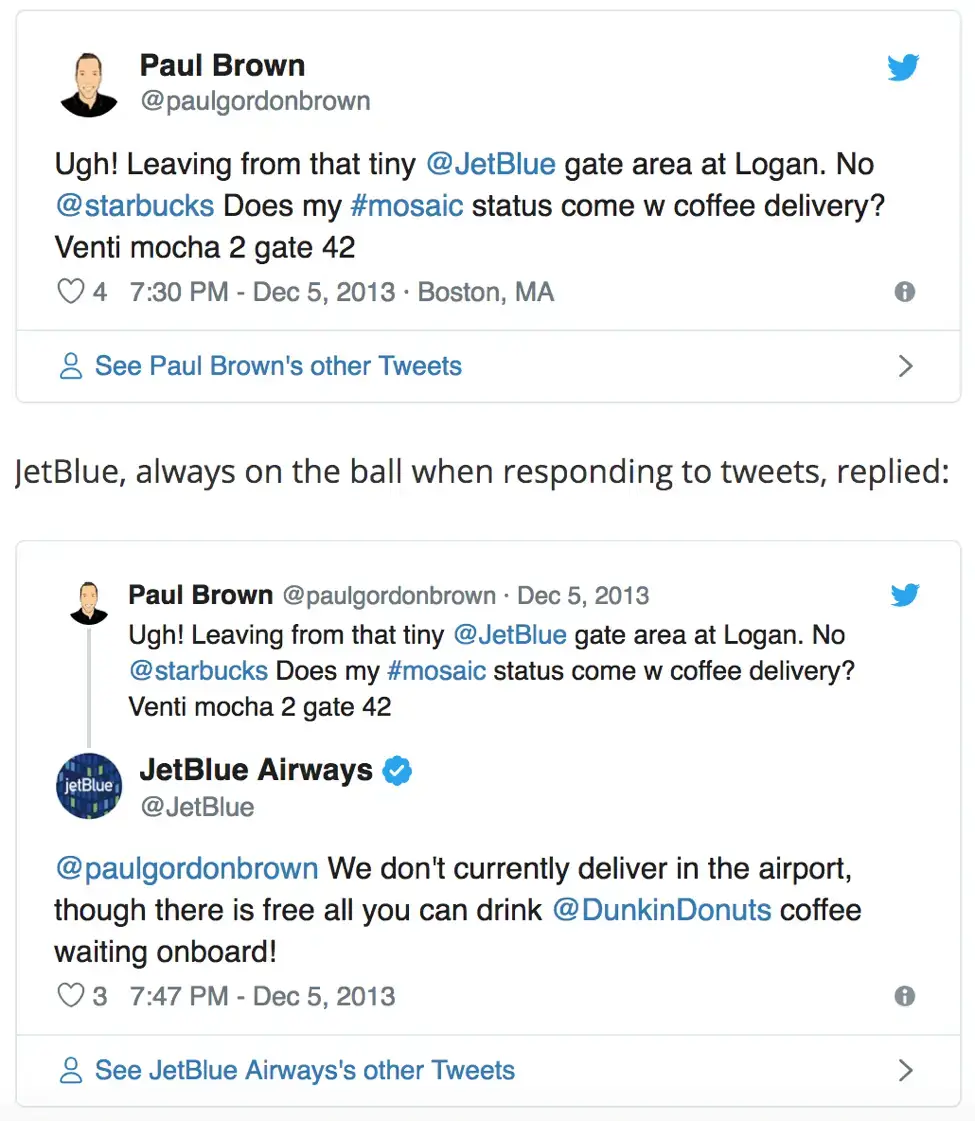
2. Tesla - Meet your customers where they’re at
Tesla literally meets customers where they’re at by going to the customer’s home and fixing issues on their car. It’s convenient for the customer because they don’t have to sit around a repair shop and it can be scheduled on their own time. This is an example of excellent customer service.
Flat tire on Sunday. Called Tesla, git a loaner tire within 40 minutes. Today they came to my house to replace the tire in 10 minutes. scheduled to come back to fix a small issue next week. What other car company does this? @elonmusk @TeslaModel3 @Tesla #mobileservice pic.twitter.com/GiNwOM3RJZ — Chris Kern (@cjk7216) October 31, 2018
3. Adobe - Respond to customer service complaints before they happen
When Adobe had an outage due to an issue with Amazon Web Services, they posted a tweet about it before they started getting customer complaints. The tweet contained a video of a puppy stampede as a distraction and lightened the mood. While there were some comments asking when the program would be running again, many replies focused on the adorable puppies.
Hi all, some Adobe services are down due to the AWS outage: https://t.co/U2qtybaT8J Here's a puppy stampede to take your mind off of it. ? pic.twitter.com/Glv6Anavje — Adobe Customer Care (@AdobeCare) February 28, 2017
4. Trader Joe's - Help those in time of need
An 89-year-old man was stuck in his house during a snowstorm and his granddaughter was worried he wouldn’t have enough food. She called around to several grocery stores and asked if they would deliver, to no avail. Finally, Trader Joe’s said they normally don’t deliver, but they would help. She read off a big list to the store and they delivered the entire order and more within 30 minutes, free of charge.

5. Coca-Cola - Get involved in social causes
Since 1984, Coke has given back more than $1 billion through the Coca-Cola Foundation. What’s great is they give back at the local level and not just to large organizations. For instance, Coke in Ireland initiated the Coca-Cola Thank You Fund , which gives €100K annually to local charities that empower young people, foster sustainability, and encourage diversity and inclusion.
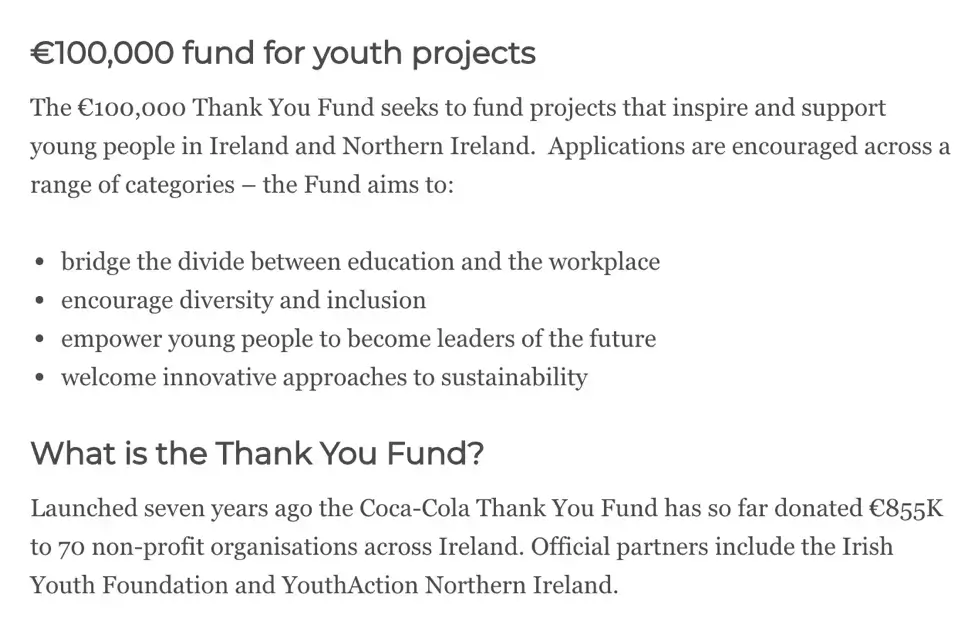
6. Zappos - Personally reply to every email
Zappos responds to every email it receives, even if it’s addressed to the CEO. In this case, a woman sent a request to Tony Hsieh and even though he was unavailable, his representative sent a humorous and engaging email back.
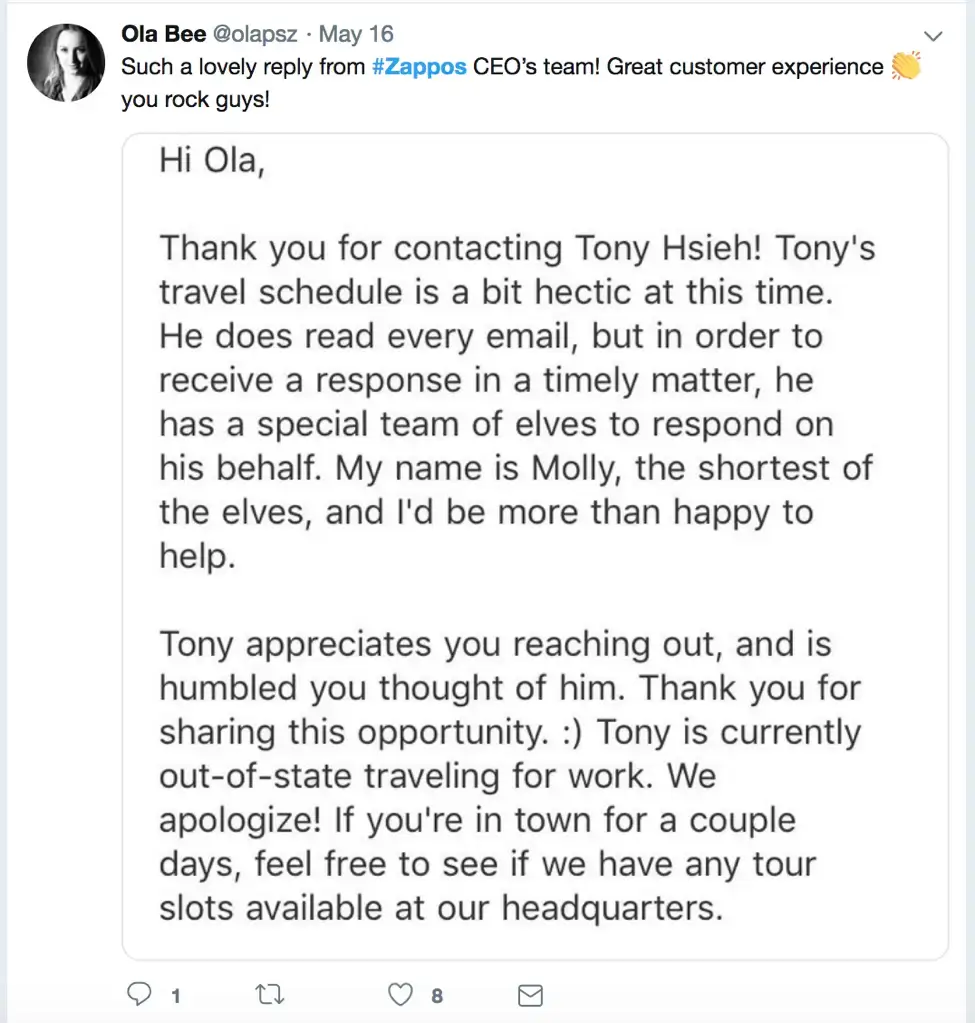
7. Us! - Provide an exceptional event experience
During many conferences that we attend, we send our “Qualtrics Dream Team” to fulfill customers' needs and wishes to make the event a truly exceptional experience. From food and drinks, to swag, to even vacations and massages, our team tries to fulfill as many requests as possible. They also collect customer feedback and make changes for a better event experience, such as room temperature and providing phone chargers.
Not a legal comment, but every other company listed here has some example of a customer thanking them for good customer service. I think our example would be stronger if we had something like that.
Curious to know how we run the Dream Team using our own software, or why we bring it to events like #CXOLeadersSummit ? Stop by our booth and we'll share all the secrets! Our team is here till 4pm AEST. pic.twitter.com/pEjfd2Jl8K — Qualtrics (@Qualtrics) August 8, 2018
8. Sainsbury’s – Don't be afraid to change everything
When Sainsbury’s, a UK supermarket chain, received a letter from three-and-a-half-year-old Lily Robinson, they ended up rebranding one of their products entirely. Lily thought their "tiger bread" didn’t resemble a tiger’s stripes at all – it looked more like the pattern on a giraffe. Sainsbury’s responded that the little girl was right and made new labels to share Lily's insight with other customers.

9. American Express – Give customers benefits that can be used globally
American Express maintains their position as a top-tier credit card company by offering its customers plenty of extra benefits: complimentary travel flight credit, insurance, and access to airline lounges to name a few. Combine these worldwide benefits with American Express's 24/7 support line and its global partners network and you have a company that truly connects with you wherever you are.

10. Walmart - Invite customers into the company family
Walmart has a reputation for being focused on providing value to everyday families. They live out their family focus through the way they treat their employees. When one of their associates turned 101 years old, they shared the news on Facebook and invited customers to participate in the celebration.

11. The Ritz-Carlton Hotel Company – Turn customer errors into service opportunities
Ritz-Carlton employees are allowed up to $2,000 to fix any guest problem, no questions asked. One example was told by customer John DiJulius, who left his charger behind at The Ritz-Carlton Sarasota. He received a next-day air package with his charger and a note saying ‘Mr. DiJulius, I wanted to make sure we got this to you right away. I am sure you need it, and, just in case, I sent you an extra charger for your laptop.’
How to provide great customer service
The best way to provide a good customer service experience is to gather feedback, set metrics and take action on your overall customer experience (CX) .
Why not check out our free survey template to collect feedback for customer service and contact centers? You can download it here.
With Qualtrics, you can track key metrics with a customer service benchmark report to help you to understand how your service is improving over time. Track interactions and feedback across the customer journey and customer service experience, and set action into motion to gain customer trust and loyalty.
Best customer service practices: Improving agent effectiveness
Diana Kaemingk
Diana Kaemingk is a contributor to the Qualtrics blog.
Related Articles
May 6, 2024
New innovations for the XM Platform showcased at X4 2024
May 3, 2024
X4 2024: Reimagining human experiences with AI
May 2, 2024
X4 2024: Humanized Intelligence
April 16, 2024
A better way to measure and improve patient access
April 11, 2024
Omnichannel vs. multichannel customer experience
March 30, 2024
The 50 companies with the best customer service
March 21, 2024
Turning reactive CX into proactive CX
March 11, 2024
Conversational AI: Exploring the future of experience management
Stay up to date with the latest xm thought leadership, tips and news., request demo.
Ready to learn more about Qualtrics?

Customer Experience
5 Case Studies to Improve Your Customer Service

As more and more customer transactions occur virtually, the quality of online help desks and customer service support is becoming an essential differentiator for companies. An estimated 73% of consumers say a good experience is critical in influencing their brand loyalties.
Customer satisfaction directly impacts the bottom line, too, as 84% of companies that work to improve their customer experience report an increase in their revenue.
Apart from the stats, it is important to look for examples of company success stories improving customer service and productivity. Having high-performance customer service is essential for any company, regardless of industry. Check out these five case studies that will help you improve this process in your business.
How Quick Heal optimized their customer service, extending support hours and responding to inquiries faster
Quick Heal Technologies is a leading provider of internet security tools and anti-virus software, serving millions of users worldwide. Like many fast-growing companies, they experienced bottlenecks in their customer service process due to the high volume of requests.
- No system to track requests from different sources.
- Agents could not maintain a global view of the customer request, negatively impacting customer service.
- High incidence of lost tickets and incomplete information.
- Customers were not happy with the support delays.
- The existing system did not manage its workflow.
Quick Heal researched several options yet didn’t find a solution with the right blend of factors. That’s when the team signed up for a free trial of Kayako. Before the free trial even ended, Quick Heal decided that Kayako was the right solution.
Kayako’s Shared Inbox Solution creates a frictionless experience by unifying interactions from different sources like email, Facebook, Twitter, and live chat. The Shared Inbox Solution means QuickHeal agents can serve customers more efficiently while preventing dropped tickets and lost conversations.
Kayako Benefits for Quick Heal:
- Reduced ticket response and resolution times
- Improved collaboration and reduced duplication of effort
- Extended support hours
- Consolidated conversations from multiple sources
“Without Kayako, we would not be able to manage all of the incoming ticket requests in an organized manner nor provide the quality of support we stand for. Kayako is far more efficient than our previous help desk system.” Sushant Dashputre, Assistant Manager of Technical Support at Quick Heal
Are you ready to deliver Friction-Free Customer Service? Capture your customer’s entire journey in a way a support ticket or traditional help desk never could. Discover Kayako Single View
Increasing NameCheap’s agent productivity through a self-service knowledge base
Namecheap is a leading domain registrar and technology company that offers domain registration, hosting packages, and related services. Customer support is vital to Namecheap, especially because they serve many repeat customers. Scaling personalization in support is imperative to avoid customer churn.
- No optimized workflow for the high volume of requests led to customer complaints.
- Due to a complicated and overwhelming process when responding to customer tickets, Agents became stressed.
- Low productivity for service agents.
Namecheap began to look for a reliable, unified customer service software solution. They had difficulty finding an option that fit all their needs. The Namecheap team then learned about Kayako and decided to try it.
After Namecheap integrated Kayako into their website, they saw an immediate improvement in agent productivity. They implemented a Self-Service Portal with tools like macro-libraries of responses, automated replies, and a self-help knowledge base to help customers get helpful answers anytime they need help.
Kayako’s SingleView gives agents a complete visualization of the entire customer journey, from initial purchase to most recent customer service inquiry for individualized customer questions needing personalized support. Kayako enables Namecheap to scale personalized customer service, the holy grail for companies with a high volume of repeat customers.
Kayako Benefits for Namecheap:
- Improved self-service knowledge base.
- Streamlined ticket management.
- Boosted productivity.
- Increased customer satisfaction.
“One of the things we most value about Kayako is how carefully they have thought about real-life support processes. In all aspects, Kayako provides us with value in buckets.” Nata Trusova, Director of Customer Support at Namecheap
How Envato manages multiple customer bases in one place and resolves tickets faster
Envato is a world-leading online community for creatives. The company’s steady growth since 2006 outpaced its existing resources for support requests. Envato tried building their own help desk and quickly saw that a DIY solution would be prohibitively expensive in terms of time and money.
They began to search for an existing customer service software solution that could meet their needs and fit their budget.
- Existing support system not keeping up with the volume of requests.
- Support requests were hard to track, sometimes going to individual emails.
- Envato managed multiple customer databases and needed a way to coordinate them.
Using Kayako’s SingleView dashboard, Envato could access multiple customer databases in just one place. SingleView provides a complete view of the customer journey so that customer service agents can provide personalized support to every customer.
Using features like Kayako’s ticket parsing rules, Smart Routing and internal collaboration tools helps Envato efficiently give customers accurate answers every time. With Kayako, the Envato team handles more requests in less time while increasing the quality of customer service. Best of all, Kayako is a scalable solution that can grow with Envato.
Kayako Benefits for Envato:
- Resolved tickets faster.
- Managed all customer databases in a single system.
“Kayako has allowed us to extensively customize our help desk. This really meant that we can just make our help desk work in the way we want, rather than coming up with an elaborate system to fit into the technical requirements of other help desks. It has functionality that other support providers have not been able to match.” Jordan McNamara, Community Manager, Envato
Increasing Texas Tech´s customer satisfaction with a communication and collaboration platform
Texas Tech University is a top institution focused on advancing higher education, research, and health care. With more than 10,000 employees and over 36,000 students, their support team was overwhelmed with the volume of service requests.
- Support staff, students, faculty, and many other stakeholders were frustrated because the system couldn’t handle the high volume of support requests.
- The situation reflected poorly on their brand as a top higher education institution.
- Staff was trying to manage support requests using a shared Outlook account.
- They had no way to collaborate internally on support requests.
After comparing different options, Texas Tech chose Kayako because it offered Kayako Collaborators Feature they needed to coordinate internal communications and to serve customers with faster responses.
Their team quickly implemented Kayako’s out-of-the-box features and immediately saw improvement.
“Once we implemented Kayako, we immediately noticed an increase in the quality of communication and collaboration, especially between our support and development team. Our customers also praised the improved communication.” Kevin Eyck, Enterprise Server Administrator, Texas Tech University
Kayako’s integrated self-service feature helped Texas Tech reduce the number of live-agent.
tickets by assisting customers in helping themselves. Texas Tech also leveraged Kayako’s customization options, using a custom LoginShare and integrating it with the intranet and applications used on their campus.
Kayako didn’t just help Texas Tech improve the support experience for the customer; it also enhanced their internal team’s productivity.
With Kayako, Texas Tech University handles all of its support requests quickly and easily resolves customer problems. Customers also benefit from the improved processes for ticket management and communication.
Kayako Benefits for Texas Tech University:
- Reduced the number of support tickets.
- Improved internal collaboration.
- Gained self-service capability.
How Kayako helped CoinStop reduce average response time and implement omnichannel customer support
Coinstop is a trusted provider of cold storage cryptocurrency hardware wallets. After launching in 2016, Coinstop experienced extremely rapid growth.
They soon struggled to manage and respond to all of the support inquiries and questions from potential customers. The Coinstop team began searching for a customer service software solution that was easy to use and implement.
- Rapid growth was putting a strain on the existing bare-bones support process.
- Coinstop must spend time educating customers as well as selling to them.
- Customer service practices did not scale with the company.
- Coinstop was providing customer support using a single email account.
- Manually responding to hundreds of emails per day wasn’t a productive use of time.
- There was no way to track the progress of support requests, they couldn’t standardize responses across the various agents, and they found themselves asking repetitive questions that frustrated their customers.
Coinstop needed a help desk and live chat software to organize and optimize their support. They chose Kayako customer support software because it offers the best experience for both support agents and customers.
Using the Kayako dashboard, agents can interact with customers across multiple social platforms, email, and live chat. Agents can see the customer’s history from all channels, not just chat or email.
Everyone on the Coinstop team has immediate access to all the information they need to provide quick, personalized support to customers with Kayako’s SingleView.
Kayako Benefits for Coinstop:
- Reduced average response time.
- Managed a higher volume of tickets with the same number of agents.
- Improved collaboration between departments.
- Implemented omnichannel support.
“You need one place to browse every single conversation you have had with each customer. Kayako is very well organized. You can tie everything into it, including emails, social media, and team members.” Christopher Pavlesic, Co-Founder of Coinstop
Are you ready to increase your team’s efficiency? Provide a better employee experience and speed up internal support with Kayako HelpDesk. Discover Kayako Self Service
Common Challenges, Custom Solutions for Customer Service Help Desk
As you can see, companies across a spectrum of industries often share similar challenges with customer service. Do you have questions about improving your customer service process? Join world-class customer support teams like the companies in these case studies using Kayako to deliver exceptional customer experiences. Book a Demo today.
What you should do now
- Start your free trial or take the tour to learn more about Kayako
- Increase your knowledge on everything related to customer support with our free eBooks , Webinars and Case Studies
- If you know anyone who'd enjoy this content, share it with them via email, LinkedIn, Twitter or Facebook.
Deliver Excellent Customer Support Experiences With Ease
Keeping now integrates directly with HubSpot's Sales Hub. Learn More
- Customer Interaction
4 Customer Service Case Studies to Inspire You
Customer service case studies help attract new customers to your business by showing them how your company can help them. Instead of simply telling customers what you can do for them, you demonstrate it with storytelling and draw them in.
Last updated: November 24, 2022
6 mins read
If you’ve researched any brand it’s more than likely you’ve come across a customer service case study. Real-life customer experiences are a powerful way to advertise a brand and showcase the real interactions customers have when approaching a company’s customer service department.
Instead of simply telling a customer what it’s like to benefit from a company’s customer service, they demonstrate genuine examples of customers who have submitted tickets to their customer service team.
On the surface of it, one company can appear much like another without powerful customer service case studies to demonstrate its impact. Customers will be required to actually sign up to your service before they can experience your customer support for themselves.
What is a customer service case study?
A customer service case study is a strategy to show the experiences of customers that have actually signed up to use your product or service and have actually witnessed your customer service for themselves.
Potential customers who are researching what your company has to offer will benefit from the case studies of customers that have already passed through the buying decision. Instead of a company simply telling prospective customers what they have to offer, they will be able to demonstrate their service in reality.
A customer service case study goes beyond being a simple testimonial, however. It’s factual evidence of customers who have implemented your company’s product or service and a demonstration of its ability to actually deliver results.
Why are customer service case studies important?
Without customer service case studies, your business will struggle to show how it is helping its customers. A case study shows your prospective customers how the business has performed in a real-life example of customer service, and helps them imagine what it would be like to do business with your company.
Customer service case studies show potential customers how your business has helped customers to solve their problems and further their business goals. Although there are other ways to market your business, customer service case studies are a solid way to reach out to new prospects and convert them into customers.
Successful customer case studies showcase successful examples of customer service that persuade your prospects to actually buy. They show prospects how well your customer service actually works and highlights your product’s value.
How do you write a customer service case study?
There are a few strategies you need to follow when writing a customer service case study. Having a variety of different case studies will enable you to reach more potential customers which cover a range of situations and needs.
1. Focus on your personas
You need to consider the type of the customer that you want to attract with your customer service case study. Mapping out your personas is an important part of your marketing strategy because it helps you identify prospects with unique wants and needs. Your customer service may appeal to different types of individuals and it’s crucial to target each one specifically.
2. Tell a story
At their core, customer service case studies are stories about particular customers. Simply raving about how great your company is wil be boring for your readers, and you need to take them on a journey. Stories need to have obstacles to overcome, and your case study should show how your product or service is the hero of the narrative.
3. Emphasize benefits
The benefits of your customer service will help to appeal to customers that have a specific pain point to solve. Instead of focusing on products or features it’s important to show how your service will help them. Your customer service case study is likely to be a representative example of a customer that has similar problems to other prospects, and it’s important to help prospective customers visualize using your service.
4. Highlight the results
Highlighting the results that your customer service will help your customers achieve means focusing on the before and after of using your service. Genuine improvements to your customer’s business will help to convince them that your product or service is the answer. Showing the results of your customer service helps customers see how they can save or make more money after choosing your business.
4 interesting customer service case studies
Quick heal and kayako.
Here’s the first interesting customer service case study from Kayako. There was a company called Quick Heal Technologies which was a provider of internet security tools and anti-virus software. They had millions of global users, but they were struggling to deliver outstanding customer service due to a high volume of customer service requests.
One of their main issues was the absence of a system to track requests from different sources. Agents were checking many different platforms for customer service requests, and lacked a vital overview of the customer experience. They were losing tickets and suffering from incomplete information. There were delays in the customer support experience and the existing system couldn’t manage its workflow.
Enter Kayako, help desk software. Their Shared Inbox Solution brought together the different customer service platforms such as email, Facebook, Twitter, and live chat. Quick Heal agents were able to support customers seamlessly and minimize the number of tickets that were dropped. They could significantly reduce their ticket response times and accelerate the time to resolution. Agents were able to much more effectively collaborate and reduce duplication of effort.
Springboard and Help Scout
The next customer service case study is about Springboard, a platform which provides online resources and personalized mentors to help students build their dream careers. Their aim is to make a great education accessible to anyone in the world.
So far, they have worked with 250 mentors to train more than 5,000 students over 6 continents. Their success has depended on their ability to create an open environment where students feel comfortable requesting feedback and discovering course information on their own.
Springboard needed a solution that could help them build relationships with their students, even if it’s over email, and they decided that Help Scout was the answer. They chose Help Scout because it means they can have human conversations rather than treating their students like a ticket number.
They make use of Help Scout’s help desk features to find key insights into students’ conversations, as well as their Docs knowledge base which provides answers to common questions. As a result, students are able to more effectively learn and overcome problems when they arise.
We’ve got another customer service case study from an airline – in this case, JetBlue. They really know how to make their customers smile with small gestures and ensure they can win customers for life.
One customer called Paul Brown was flying with JetBlue from the smaller terminal at Boston’s Logan airport. He realized that he couldn’t grab his usual Starbucks coffee because there was no Starbucks at the terminal. On a whim, he sent a tweet to JetBlue asking them to deliver his venti mocha, and to his surprise they obliged! Within minutes JetBlue customer service representatives had delivered the coffee to Paul’s seat on the plane.
This example of customer service shows that JetBlue is willing to go the extra mile for customers and will ensure that the company can continue to attract more customers.
Gympass and Slack
Gympass is an international platform that gives companies and their employees 50% to 70% off a global network of fitness studios, digital workouts, and mental health and nutrition services. It was founded in 2012 and has experienced steady growth, now worth more than USD $1 billion. Users of Gympass have access to 50,000 gyms and studios in more than 7,000 cities, so they can work out while they are on the move.
The problem with this growing company was communication across the globe. The company was overly reliant on emails which led to silos and employees missing out on vital information. The solution to this problem was Slack, a communications platform which is made accessible to all new employees so they have everything they need right from the start.
Now, teams at Gympass work across a range of 2,000 Slack channels which are open to 1,000 employees. They can share documents, messages and information, keeping connected across locations and facilitating new projects like event planning. It’s enabled Gympass to build a strong culture of collaboration and ensure that every employee can find the information they need.
Wrapping up
Customer service case studies help attract new customers to your business by showing them how your company can help them. Instead of simply telling customers what you can do for them, you demonstrate it with storytelling and draw them in. Showing your customers benefits and outcomes support them to make the decision to purchase.
Before they actually have a trial of using your product or service, it’s hard for customers to know what it would be like. Case studies can give a valuable preview into what it would be like to work with your company and highlight customers that have already achieved success.
Catherine is a content writer and community builder for creative and ethical companies. She often writes case studies, help documentation and articles about customer support. Her writing has helped businesses to attract curious audiences and transform them into loyal advocates. You can find more of her work at https://awaywithwords.co.
Join 150+ teams that are sharing inboxes with us
The easiest way to upgrade your shared Gmail account. There’s no credit card is required.
The Missing Shared Inbox for Google Workspace
Continue reading.
27 Hilarious Customer Service Jokes
Sorry for the Late Response: How to Apologize in Email
The Golden Rules of Communication with Customers
The state of customer care in 2022
Customer care leaders are facing a perfect storm of challenges: call volumes are up, employees are leaving and harder to replace, and digital solutions aren’t yet delivering on their full promise. Add rising customer expectations and decades-high inflation to the mix, and it’s easy to understand why customer care leaders are feeling the pressure.
About the authors
This article is a collaborative effort by Jeff Berg , Eric Buesing , Paul Hurst, Vivian Lai, and Subhrajyoti Mukhopadhyay, representing views of McKinsey’s Customer Care service line.
The stakes couldn’t be higher as teams try to adapt to a postpandemic era of customer care. Over the past two years, leaders have had to quickly adapt systems and ways of working to accommodate the shift to working from home—up to 85 percent of their workforces, in some cases. Contact center employees are harder to hold onto, and nearly half of customer care managers experienced increased attrition in 2021, leading to performance variability.
Over the past two years, customer care leaders have had to quickly adapt systems and ways of working to accommodate the shift to working from home.
While digital solutions and the shift to self-service channels will solve many of these challenges, they aren’t quite reaching the goal. For most organizations, the vast majority of digital customer contacts require assistance, and only 10 percent of newly built digital platforms are fully scaled or adopted by customers.
Not surprisingly, McKinsey’s 2022 State of Customer Care Survey has found that customer care is now a strategic focus for companies. Respondents say their top three priorities over the next 12 to 24 months will be retaining and developing the best people, driving a simplified customer experience (CX) while reducing call volumes and costs, and building their digital care and advanced analytics ecosystems.
With challenges on all fronts, the question now confronting leaders is how best to prioritize investment across the people, operations, and technology aspects of their customer care strategies. Knowing where to focus or what to do first isn’t easy, and businesses need to move quickly. Companies that don’t invest in this area face the possibility of further talent attrition, customer dissatisfaction, and even loss of market share.
But customer care is also now a major opportunity for businesses. Done well—through a combination of tech and human touch—it is an area where companies can drive loyalty through a more personalized customer journey while unlocking greater productivity, increased revenue, improved job satisfaction, and real-time customer insights.
This article presents the key findings of the 2022 State of Customer Care Survey and how businesses are shifting priorities at this critical time.
Challenges on all fronts
To uncover the latest trends in customer care, McKinsey surveyed more than 160 industry leaders and experts at the director, senior director, vice president, and C-suite levels to find out how their operations have been affected over the past two years of the COVID-19 pandemic.
Care is at an inflection point
The survey findings indicate that customer care is at an inflection point. Call volumes are higher and more complex than before, while companies find themselves struggling to find talent and train them to proficiency at pace.
As customer care increasingly moves online, the distinction between digital and live interactions has also begun to blur. Organizations are looking for new capabilities that will enhance both the customer and employee experience in “moments that matter”—those interactions that may have previously happened face to face or have significant influence on overall CX.
Compared with results of the 2019 State of Customer Care Survey, customer care leaders are now more focused on improving CX, reducing contact volumes, deploying AI assistance, and increasing revenue generation on service calls (Exhibit 1).
Customer care talent is increasingly scarce
Higher call volumes and more complex calls are challenging existing capacity—61 percent of surveyed care leaders report a growth in total calls, with increased contacts per customer and a growing customer base as the key drivers. And 58 percent of care leaders expect call volumes to increase even further over the next 18 months.
While a growing customer base is a positive sign for business, it puts greater pressure on contact centers that are already under strain. More customers mean increased call numbers, and with more complex calls, customers tend to have to phone contact centers over and over again—further affecting capacity and resulting in a more negative CX overall.
To make matters worse, talent attrition is affecting customer care capacity. Employees are leaving faster than they did before the pandemic—a result of the Great Attrition—and are more difficult to replace. Nearly half of surveyed managers report increased employee attrition over the past 12 months.
The top-cited reason for employees leaving is poaching by competitors—58 percent—alongside employee burnout, employee dissatisfaction, lack of advancement opportunities, and poor work–life balance (Exhibit 2).
Retaining talent could prove vital in the race to maintain capacity. New hires require significant staff training, with 41 percent of surveyed leaders reporting that it takes between three and six months to train a new employee for optimal performance and a further 20 percent saying it takes more than six months.
Uniting self-service and live channels
Many companies have made significant investments in digital care capacity in recent years, though cross-channel integration and migration issues continue to hamper progress. For example, 77 percent of survey respondents report that their organizations have built digital platforms, but only 10 percent report that those platforms are fully scaled and adopted by customers. Only 12 percent of digital platforms are highly integrated, and, for most organizations, only 20 percent of digital contacts are unassisted.
In an increasingly digital first environment, however, customer care is fundamental to how organizations interact with their customers. Leaders in this field are asking, “How do we create a better, more personalized experience through digitally enabled services?”
Businesses are investing in three critical areas
Faced with the challenges of a fast-changing and demanding environment, companies can’t afford to refrain from acting on the customer care storm. Over the past two years, customers have flocked to digital channels because of the pandemic, and organizations have had to race to meet their needs with new channels that support remote and digital transactions.
Would you like to learn more about our Service Operations practice ?
In a postpandemic future, this pivot to digital is likely to keep growing. And while many companies believe that they have made significant strides in their customer care transformation journey, a significant number remain at a foundational level—they are improving self-service options and automating common requests but haven’t yet moved far enough along the journey to distinguish from their competitors. Meanwhile, those that have the leading edge are leveraging real-time customer behavior insights and conversational AI to deliver proactive customer outreach.
Customer care leaders say their top three priorities over the next 12 to 24 months are to retain and develop the best people, drive a simplified CX while reducing call volumes and costs, and build out their digital care ecosystems.
Retain and develop the best people
Traditionally, customer care talent has been regarded as cheap, easy to replace, and relatively low skilled. But with call volumes growing and calls becoming more complex to resolve, these employees now require more strategic consideration.
With three out of five surveyed leaders citing attracting, training, and retaining talent as a top priority, businesses are looking at ways to build a better organizational culture. Two of the most effective ways to do this—according to customer care leaders—are to find ways to motivate and build trust with employees and to encourage leaders to listen and act on employee feedback (Exhibit 3).
Shift the interactions
Shifting the workload away from transactional, repetitive calls can address a number of the headaches facing customer care leaders. The move can free up capacity to improve CX while offering more rewarding work to employees.
Companies are looking to shift from a transactional to a solution-oriented interaction during the live, complex calls that matter most to customers. Organizations are also turning to self-service channels and tech to resolve high volumes. And the strategy is working. Nearly two-thirds of those surveyed that decreased their call volumes identified improved self-service as a key driver (Exhibit 4).
Organizations are planning to increase digital interactions one and a half times by 2024. The top three areas identified for investment include tech that improves omnichannel and digital capabilities—for example, chatbots and AI tools—automated manual activities in contact centers, and advanced analytics capabilities.
Despite digital tech taking on more of the burden for customer service interactions, human assistance will likely remain an important driver of overall CX, especially in the moments that matter. Customers want fast, efficient service, but they also want personalized customer care, whatever the channel of engagement.
Develop AI-powered customer care ecosystems
The growing challenges around increasing volumes, rising complexity, and limited talent availability are unlikely to be solved at scale without AI and data analytics. Companies can optimize the entire customer operations footprint by using tech to measure performance, identify opportunities, and deploy value-capturing change management, thus delivering critical operations insights and impact at scale.
For customers, AI-driven tools like predictive analytics can deliver a personalized and proactive experience that resolves issues before customers are even aware that they exist—enhancing CX at every point along the customer journey. Tech can also assist in developing a high-performing workforce by identifying optimal work processes and practices using analytics. Automated coaching can potentially be deployed to every individual, supporting efforts to attract, develop, and retain scarce talent.

How CEOs can win the new service game
In the AI-powered care ecosystem, around 65 percent of tasks and 50 to 70 percent of contacts are automated, creating a true omnichannel experience that provides a consistent and seamless experience across interactions. In this way, the potential of contact centers could be unlocked to become loyalty-building revenue generators through greater solutioning and sales excellence.
Putting priorities into practice
CX is fast becoming a key competitive area. Companies that don’t prioritize their strategy and digital transformation journeys are likely to face continued customer dissatisfaction, as well as talent attrition—thus threatening their brand and market competitiveness.
Getting customer care right depends on prioritizing and investing across the people, operations, and tech aspects of the customer care strategy. Companies can consider the following key steps as they look to build out their capabilities and invest in their digital care ecosystems:
- Start by setting out the vision for the customer care organization, capturing what excellence looks like.
- Conduct a rapid but thorough due-diligence-style assessment of people, processes, and capabilities, looking at the customer care operation in a new light to identify not just incremental changes but a reimagined, large-scale transformation.
- Path one follows a traditional design approach, which may take longer but prove less risky, as the entire transformation is considered at the outset.
- Path two involves an interactive and agile design, test, and iterate methodology, which may lead to new solutions quickly.
- Leverage the full suite of available technologies and analytical approaches that are driving successful outcomes in customer care, including natural language processing (NLP) and AI in frontline operations to match work to workers, together with cognitive AI assistance for resolving simpler customer queries.
Personalized digital interaction nowadays is an expectation rather than a luxury or an added perk, and customer care is the issue at the heart of this digital first environment—companies can’t afford to stumble at this juncture. If done well, however, customer care presents a great opportunity to build loyalty and long-term relationships with customers, creating organizational resilience for the future.
Jeff Berg is a partner in McKinsey’s Southern California office; Eric Buesing is a partner in the Stamford, Connecticut, office; Paul Hurst is a consultant in the Charlotte, North Carolina, office, Vivian Lai is a consultant in the New York office, and Subhrajyoti Mukhopadhyay is an expert in the Chicago office.
The authors wish to thank Karunesh Ahuja and Charles-Michael Berg for their contributions to this article.
Explore a career with us
Related articles.

Social media as a service differentiator: How to win

Prioritizing customer experience in government
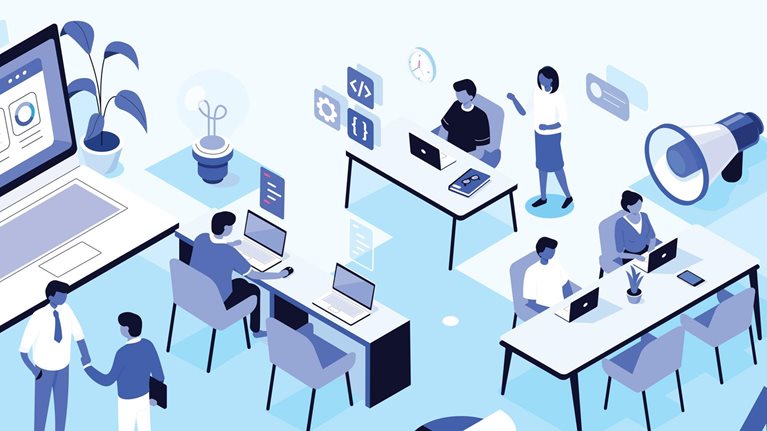
How AI-driven nudges can transform an operation’s performance
- Browse All Articles
- Newsletter Sign-Up
CustomerSatisfaction →
No results found in working knowledge.
- Were any results found in one of the other content buckets on the left?
- Try removing some search filters.
- Use different search filters.
- Integrations
- Case Studies
- State of Competitive Intelligence
- Partner Directory
- In the News
- Crayon Academy
Crayon Competitive Intelligence blog
Your guide to creating customer case studies (+ some show-stopping examples).

Teams are constantly looking for ways to stand out in crowded markets. Customer case studies may be just the differentiator companies have been seeking to give them that competitive edge. Not only do customer case studies showcase the types of pain points that a product or service can address, but they also highlight the results and successes real-life users have seen.
To put it simply, a customer case study is a real-life, detailed story that spotlights a customer’s opinions and achievements based upon the usage of a product or service.

Typically, customer case studies follow this format:
- Introduction: Setting the stage with situational context
- Challenge: Evaluating the problem at hand
- Solution: Providing an overview of how the product or service was used
- Benefits: Highlighting the key advantages
- Results: Recapping the aftereffect once the product or service was implemented
Similar to how competitive comparison landing pages provide trust and credibility for a brand through real-life recommendations, customer case studies deliver the same effect. These studies are people-focused, factual, and stray away from the promotional lingo that prospective customers have seen time and time again during their product search. After all, what prospect wouldn’t want some insight on the successes users have seen thus far?
Now that you have a better understanding of what a customer case study is, let’s dive into why they are important from a competitive standpoint and explore some tips on how to incorporate them into your marketing strategy.
The importance of customer case studies
Competition is heating up more quickly than ever before and is not expected to cool off anytime soon. Our 2021 State of Competitive Intelligence Report found that 53% of businesses say that the majority of their deals are competitive–an 8% increase from last year.
Sales teams need the help of marketers more than ever before to combat the growing number of industry rivals. To be successful in prospective calls, in particular, they need to be equipped with loads of marketing collateral, battlecards to guide them through objection-handling, and more. Customer case studies may be that piece of collateral they didn’t realize was missing from their stack to help seal the deal.
According to Eccolo Media’s 2015 B2B Technology Content Survey Report , customer case studies rank as the fifth most influential content marketing type in the purchase process for both small technology businesses and large enterprises. That’s an impressive ranking when it's being compared to assets such as product brochures, emails, and white papers. In fact, 42% of respondents said that in the last six months of the survey, they had consumed customer case studies as a way to evaluate a technology purchase.
As I’m sure you can see, there’s no doubt that customer case studies can help you stand out from your competitors. Let’s take a look at some examples that you can model yours after.
Successful customer case study examples
While some customer case studies come in the written form (typically distributed as a PDF), other organizations opt to turn it into a video–or do a combo of both.
Check out these examples from Zoom, Hootsuite, and AT&T below:
1. Zoom featuring Groupon
In this example, Zoom opted for a video case study. It opens up with a multimedia services manager at Groupon discussing the company’s pain points and then goes into how Zoom helped solve them. The video is professional, to-the-point, and highlights how Zoom has provided Groupon with a standardized platform that meets the needs of its video-first culture.
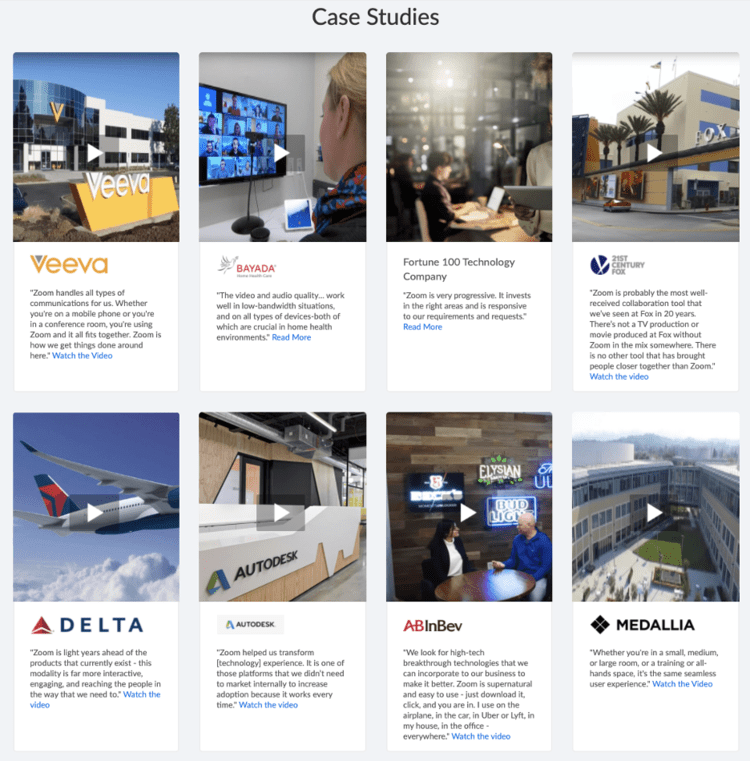
As you can see above, Zoom also has an entire web page dedicated to case study videos–all highlighting different industries but with the same end-goal–streamline companies’ telecommunications needs. It’s clear that the page can resonate with a variety of audiences and that’s the key to success.
2. Hootsuite featuring The British Museum
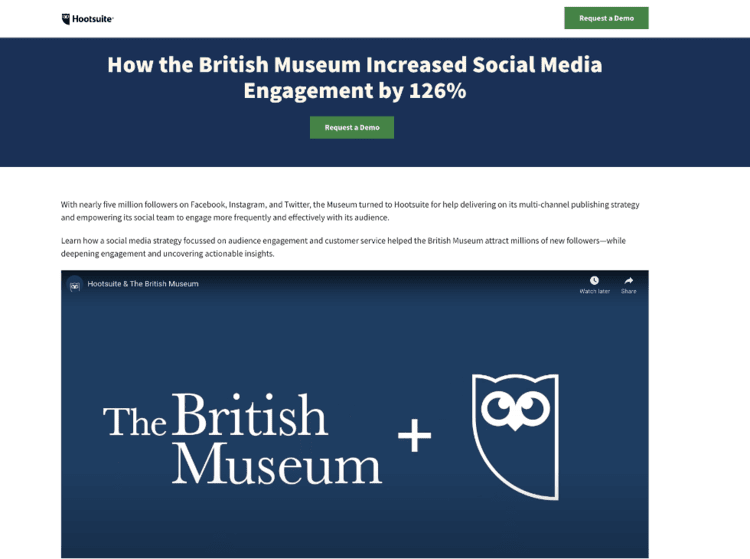
This case study example from Hootsuite is a combination of both text and video. When you first open the page, it provides some context at the top describing who is being spotlighted and why ( The British Museum ). The page then immediately dives into a video. Following that video are the following sections: “What They Did," “How They Did It," and “The Results." This approach appeals to prospects looking for both a quick synopsis (the video) or more in-depth information (the written portion).
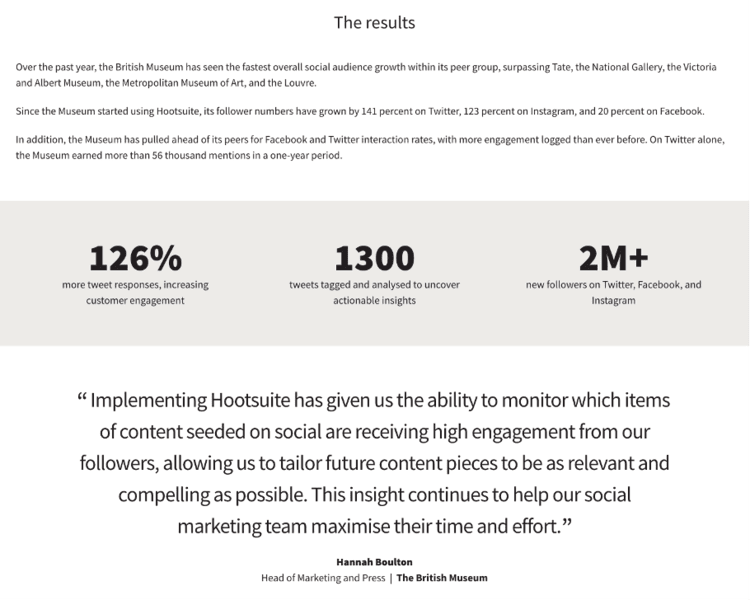
Looking at the example above, the page ends with some impressive statistics bolded to grab a reader's attention and a quote provided by a member of the customer’s leadership team. Prospects will walk away with a comprehensive understanding of how the platform could benefit them and the types of results customers have achieved.
3. AT&T featuring Birkey's Farm Store
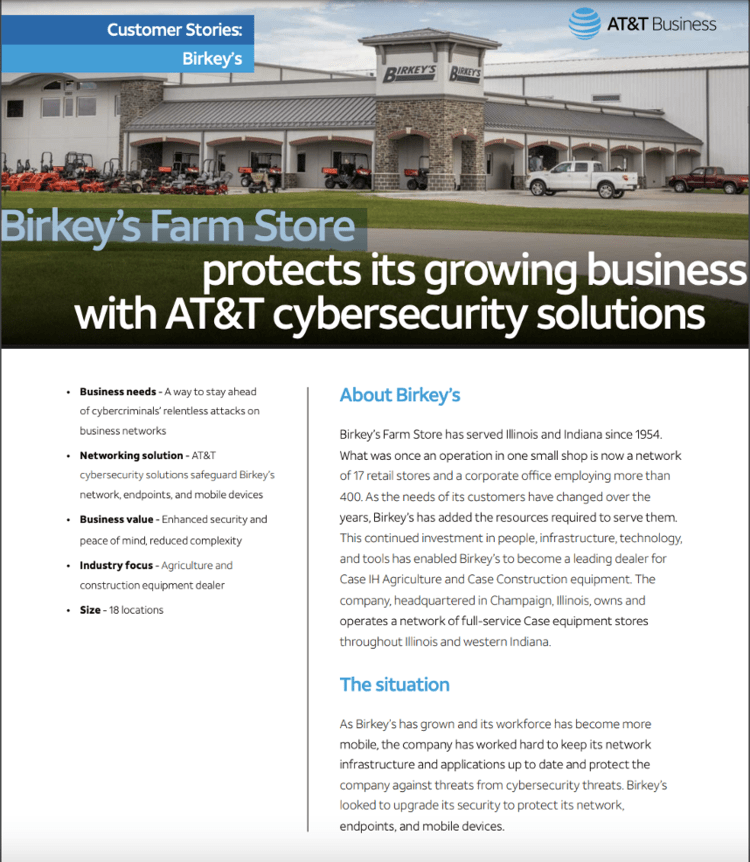
AT&T chose a more traditional route for a customer case study with Birkey’s Farm Store –a PDF format. This format ensures that all of the information is organized, clearly displayed and that the key elements are emphasized. This format allows for a visual representation of data and easy scanning for important details. For those in a time crunch, chances are they’ll prefer this format–just be sure you’re engaging readers through graphics, bolded text, colors, etc.
Historically, customer case studies were in written form but as technology evolves, videos have come into play, stealing the spotlight. While there is no right or wrong format to use (it truly does depend on a reader’s preference), it is important to note that HubSpot estimated that over 50% of consumers want to see videos from brands more than any other type of content. My vote goes to a combination of both like the Hootsuite example!
5 tips for creating a customer case study
Now that you’ve checked out some examples of what a good customer case study looks like, let’s dive into some tips on how to be successful in creating one.
1. Determine your target persona(s) upfront
Before putting pen to paper, pinpoint the groups within your target audience that your case study should resonate with. Catering your studies to specific personas will ensure that the right audience is reached and that it is relevant to your readers.
2. Connect with your team
Be sure to connect with your company’s customer success and sales teams to hear what customers they think are best to target. After all, they will have great insight since they are the day-to-day contacts. You’ll want to choose customers with whom you have strong relationships and who, of course, have seen great results based upon implementing your solution. While the case study would be “free advertising” for them, there’s no doubt that they’d be doing you a favor by going out of their way to help you bring this asset to life.
3. Create case study interview questions
Once you’ve got your customer(s) selected for the case study (and they’ve agreed to participate), take some time to draft out universal interview questions. Ideally, these questions can be used in the future and are general enough to translate to all industries that would be spotlighted on your page.
Your customer(s) will also be appreciative of your preparedness. It’s important to make the process as easy as possible for them and coming in prepared with a list, will ensure that your conversation is focused and strategic. After all, your case study needs a beginning, middle, and an end–make sure you gather enough information to put it all together into a full story.
4. Utilize statistics
Although your customer’s “results” won’t be revealed until the end of the case study, don’t shy away from using stats throughout it–in fact, it’s encouraged! Statistics stick out to any viewer and can be helpful for those trying to sway decision-makers. For example, when setting the scene, describe how many employees and locations the customer has and make those numbers stand out. Although it may seem minute, these stats can help readers determine whether their company is similar and the results achieved are comparable.
5. Build out a case study web page
It’s important to showcase your case studies in a strategic, organized, and easily accessible way (scroll back up to the Zoom example as an example). Create a designated case study hub on your website. When building out this page, it’s important to have a plethora of customer case studies–that way there will always be a case study that a prospect can relate to. Be sure that all types of industries you work with are represented and that your page is broad enough to appeal to the masses.
Incorporate case studies into your marketing plan
Marketing teams are always looking for ways to express the benefits of a product or service authentically and creatively. This type of non-promotional collateral can make a major impact on the number of leads generated and can add a new level of credibility to your brand name. It paints a picture of the types of success a prospect could have and that’s the recipe to success for any deal getting closed.
Not only do customer case studies showcase the value of your product or service, but potential customers are provided with a better sense of how real customers leverage it to excel their business. And as a bonus, it’s free publicity for your customers – that's a win-win in my book!
If you have any other tips for creating a successful customer case study, let us know in the comments below!

Seeing is believing! Check out Crayon for yourself.

Related Blog Posts
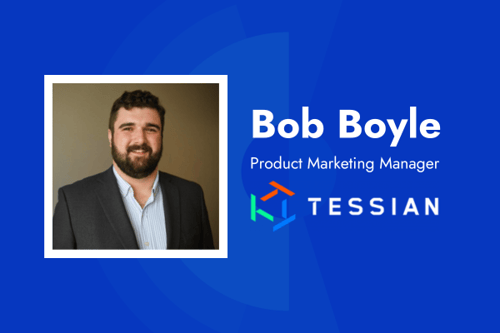
Popular Posts


Business Case Study: Zappos, A Success Story of Customer Service, Culture & Holocracy
Zappos: a case study in building a successful business, introduction:.
Zappos, an online shoe retailer, has become a household name in the world of e-commerce. Founded in 1999, the company has gone on to achieve great success, attracting attention from business experts and industry leaders alike. This case study will examine Zappos’ journey from its early days to its current status as one of the most successful e-commerce companies in the world.
Market Condition and Opportunities:
When Zappos first entered the market, the e-commerce industry was still in its infancy. Despite this, the company saw a huge opportunity in the online retail sector, particularly for shoes. At the time, most online retailers were still focused on books, music, and electronics. Zappos saw an opportunity to differentiate itself by focusing solely on shoes, offering a vast selection and outstanding customer service.
Early Wins:
Zappos' first few wins were a result of its focus on customer service and its unique company culture. The company's commitment to providing the best possible customer experience, combined with its willingness to take risks and try new things, helped it stand out in a crowded market. For example, Zappos was one of the first companies to offer free shipping and free returns, which helped to build customer loyalty. Additionally, the company's focus on employee happiness and well-being helped to create a positive working environment and contributed to its success.
Management Decisions:
Zappos' management team made a number of key decisions that helped the company achieve its early wins and reach new heights. One of the most important was its decision to focus on customer service and create a unique company culture. The company also made strategic investments in technology and marketing, which helped to build its brand and reach new customers. Additionally, Zappos was able to attract top talent by offering competitive salaries and benefits, as well as creating a positive and supportive work environment.
Secret Sauce:
Zappos' secret sauce for early success was its focus on customer service and its unique company culture. The company's commitment to providing the best possible customer experience, combined with its willingness to take risks and try new things, helped it stand out in a crowded market. Additionally, Zappos' focus on employee happiness and well-being helped to create a positive working environment and contributed to its success.
One famous story that showcases Zappos' commitment to customer service is when a customer called in to purchase a pair of shoes for her wedding, but the shoes did not arrive in time for the event. The customer service representative she spoke with went above and beyond and overnighted her a new pair of shoes, at no extra charge, so that she would have them in time for her wedding. The customer was so impressed with the level of service she received that she shared her story online, and it quickly went viral, bringing a lot of positive attention to the company.
Another example of Zappos' commitment to customer service is their "WOW" philosophy, which states that employees should do whatever it takes to make the customer happy, even if that means going above and beyond what is expected. This philosophy has led to many memorable moments for customers, such as a customer service representative spending over two hours on the phone with a customer, helping them find the perfect pair of shoes.
Capitalizing on Early Wins:
Zappos was able to capitalize on its early wins by expanding its product offerings and improving its website. The company also made strategic investments in technology and marketing, which helped to build its brand and reach new customers. Additionally, Zappos continued to focus on customer service and employee happiness, which helped to maintain its competitive advantage.
Scaling the Company:
Zappos was able to scale its business by expanding its product offerings and improving its website. The company also made strategic investments in technology and marketing, which helped to build its brand and reach new customers. Additionally, Zappos continued to focus on customer service and employee happiness, which helped to maintain its competitive advantage.
Sustaining Competition and Economic Times:
Zappos faced intense competition from established players in the online retail space such as Amazon, but the company found its unique selling proposition in its company culture and customer service. Zappos focused on providing an exceptional customer experience through fast and free shipping, a 365-day return policy, and 24/7 customer service. This differentiation strategy allowed Zappos to stand out in a crowded marketplace and to continue to grow despite the 2008 economic downturn.
In 2009, Zappos was acquired by Amazon for $1.2 billion, but the company continued to operate as an independent subsidiary. The acquisition allowed Zappos to leverage Amazon's resources to further expand its reach, but the company remained true to its roots and continued to prioritize its unique company culture and customer-focused approach.
Unique Approach to Management and Organizational Structure
Zappos adopted a unique management style called Holocracy in 2013, which aimed to eliminate traditional hierarchical structures and promote self-governance. This innovative approach aimed to empower employees and encourage them to take ownership of their work. Instead of traditional job titles, employees were organized into autonomous teams and given the freedom to make decisions that impacted their work. This allowed Zappos to foster a culture of creativity and innovation, where employees were encouraged to think outside the box and come up with new and innovative solutions. The results were significant, with increased employee engagement, improved productivity, and a more streamlined decision-making process. Holocracy also helped Zappos stay true to its core values of putting the customer first and promoting a fun, quirky and engaging workplace culture. To this day, Zappos continues to be a leader in adopting alternative management styles and continues to be a case study for businesses looking to promote employee engagement and organizational efficiency.
The Fundraising Journey of Zappos:
Zappos is known for its quirky and unique approach to business, and that extends to the way they raised funds for the company. In the early days, Nick Swinmurn, the founder of Zappos, had a tough time raising funds for his startup. But he eventually found success by approaching Tony Hsieh, a successful entrepreneur, who invested in Zappos in 1999. Hsieh was impressed with Swinmurn's vision and the potential of the company, and he saw the opportunity to apply his own experience in online marketing to help grow the business.
Zappos continued to raise funds through later rounds, including a Series C round led by Sequoia Capital, which brought in $35 million in 2004. This funding allowed the company to invest in infrastructure, marketing, and growth initiatives.
One interesting story about Zappos' fundraising efforts is the company's decision to turn down a $200 million offer from Amazon in 2000. Zappos' leadership team saw the potential for the company to become much bigger than what Amazon was offering, and they decided to go it alone. This decision proved to be a wise one, as Zappos continued to grow and eventually sold to Amazon in 2009 for a whopping $1.2 billion.
This story highlights the importance of vision and the willingness to take calculated risks in business. Zappos' leadership team believed in their vision and took a bold move by turning down a large sum of money in order to achieve their long-term goals. This decision was a testament to the company's commitment to building a unique and successful brand, and it helped lay the foundation for Zappos' success as a company.
Actionable Takeaways:
- Prioritize company culture and customer experience to create a sustainable competitive advantage.
- Leverage technology and resources to expand reach, but remain true to company values and approach.
- Continuously innovate and experiment to stay ahead of the curve.
- In conclusion, Zappos' success story serves as a shining example of what can be achieved through a customer-focused, culture-driven approach. By following in the footsteps of Zappos, companies can position themselves for long-term success and create a positive impact on their customers and employees.
"10 Things Every Business Student Should Learn From Zappos"
Zappos, the online shoe and clothing retailer, has become a leader in the e-commerce industry through its innovative and customer-centric approach to business. As a former advisor at Y Combinator, I have seen firsthand how Zappos’ success can be a valuable source of inspiration and learning for business students. Here are 10 things that every business student should learn from Zappos:
- Customer Service is KeyZappos’ commitment to providing exceptional customer service sets it apart from its competitors. The company’s approach to customer service is so unique that it is often cited as the primary reason for its success. For example, Zappos’ call center employees are empowered to do whatever it takes to satisfy customers, even if that means spending hours on the phone with a single customer.
- Embrace Culture and ValuesZappos’ company culture and values are central to its success. The company places a strong emphasis on creating a positive and enjoyable work environment, and it encourages employees to be themselves and have fun at work. This has resulted in a team of highly motivated and engaged employees who are committed to delivering exceptional customer service.
- Prioritize Employee HappinessZappos recognizes the importance of employee happiness in driving business success. The company has implemented a number of programs and initiatives designed to promote employee wellbeing, including a “Paid Time Off” program, which allows employees to take paid time off whenever they need it. This has resulted in a highly motivated and engaged workforce that is committed to delivering outstanding customer service.
- Innovate ContinuouslyZappos has a culture of innovation and is always looking for ways to improve its products and services. The company regularly launches new initiatives and experiments with new business models, which has allowed it to stay ahead of its competitors and maintain its position as an industry leader.
- Focus on People, Not Just ProductsZappos’ success is built on its focus on people, not just products. The company places a strong emphasis on building relationships with its customers, employees, and partners, which has helped it to create a loyal and engaged customer base.
- Encourage Employee EmpowermentZappos empowers its employees to make decisions and take risks, which has helped to foster a culture of innovation and creativity. The company encourages its employees to share their ideas and provides them with the resources and support they need to bring their ideas to life.
- Foster a Sense of CommunityZappos has a strong sense of community and encourages its employees, customers, and partners to engage with one another. This has helped to create a loyal customer base and a positive company culture, which are key to its success.
- Lead with PurposeZappos is driven by a clear sense of purpose, which is to deliver happiness to its customers, employees, and partners. This purpose guides all of the company’s decision-making and helps to keep it focused on its goals.
- Embrace FailureZappos recognizes the value of failure and encourages its employees to take risks and embrace failure as a learning opportunity. This has helped the company to innovate and continuously improve its products and services.
- Focus on Long-Term GrowthZappos is focused on long-term growth and has a long-term perspective on its business. This has helped it to weather economic downturns and remain competitive in a rapidly changing industry.
In conclusion, Zappos success is a result of its innovative and customer-centric approach to business. From its commitment to exceptional customer service, to its focus on employee happiness and empowerment, to its continuous innovation, Zappos is a valuable source of inspiration for business students. By incorporating these lessons into their own approach to business, students can build successful companies that are driven by purpose, innovation, and a focus on people.
“The author generated this text in part with GPT-3, OpenAI’s large-scale language-generation model. Upon generating draft language, the author reviewed, edited, and revised the language to their own liking and takes ultimate responsibility for the content of this publication.”
Leave a Comment Cancel reply
Save my name, email, and website in this browser for the next time I comment.
Subscribe now!
Maximize Your Potential with Every Issue. Join the community of 10,000+ readers who receive exclusive insights on personal growth.
Join now to receive exclusive insights & actionable steps in your inbox.
Ask me later
How to Write a Case Study: Bookmarkable Guide & Template
Published: November 30, 2023
Earning the trust of prospective customers can be a struggle. Before you can even begin to expect to earn their business, you need to demonstrate your ability to deliver on what your product or service promises.

Sure, you could say that you're great at X or that you're way ahead of the competition when it comes to Y. But at the end of the day, what you really need to win new business is cold, hard proof.
One of the best ways to prove your worth is through a compelling case study. In fact, HubSpot’s 2020 State of Marketing report found that case studies are so compelling that they are the fifth most commonly used type of content used by marketers.

Below, I'll walk you through what a case study is, how to prepare for writing one, what you need to include in it, and how it can be an effective tactic. To jump to different areas of this post, click on the links below to automatically scroll.
Case Study Definition
Case study templates, how to write a case study.
- How to Format a Case Study
Business Case Study Examples
A case study is a specific challenge a business has faced, and the solution they've chosen to solve it. Case studies can vary greatly in length and focus on several details related to the initial challenge and applied solution, and can be presented in various forms like a video, white paper, blog post, etc.
In professional settings, it's common for a case study to tell the story of a successful business partnership between a vendor and a client. Perhaps the success you're highlighting is in the number of leads your client generated, customers closed, or revenue gained. Any one of these key performance indicators (KPIs) are examples of your company's services in action.
When done correctly, these examples of your work can chronicle the positive impact your business has on existing or previous customers and help you attract new clients.

Free Case Study Templates
Showcase your company's success using these three free case study templates.
- Data-Driven Case Study Template
- Product-Specific Case Study Template
- General Case Study Template
You're all set!
Click this link to access this resource at any time.
Why write a case study?
I know, you’re thinking “ Okay, but why do I need to write one of these? ” The truth is that while case studies are a huge undertaking, they are powerful marketing tools that allow you to demonstrate the value of your product to potential customers using real-world examples. Here are a few reasons why you should write case studies.
1. Explain Complex Topics or Concepts
Case studies give you the space to break down complex concepts, ideas, and strategies and show how they can be applied in a practical way. You can use real-world examples, like an existing client, and use their story to create a compelling narrative that shows how your product solved their issue and how those strategies can be repeated to help other customers get similar successful results.
2. Show Expertise
Case studies are a great way to demonstrate your knowledge and expertise on a given topic or industry. This is where you get the opportunity to show off your problem-solving skills and how you’ve generated successful outcomes for clients you’ve worked with.
3. Build Trust and Credibility
In addition to showing off the attributes above, case studies are an excellent way to build credibility. They’re often filled with data and thoroughly researched, which shows readers you’ve done your homework. They can have confidence in the solutions you’ve presented because they’ve read through as you’ve explained the problem and outlined step-by-step what it took to solve it. All of these elements working together enable you to build trust with potential customers.
4. Create Social Proof
Using existing clients that have seen success working with your brand builds social proof . People are more likely to choose your brand if they know that others have found success working with you. Case studies do just that — putting your success on display for potential customers to see.
All of these attributes work together to help you gain more clients. Plus you can even use quotes from customers featured in these studies and repurpose them in other marketing content. Now that you know more about the benefits of producing a case study, let’s check out how long these documents should be.
How long should a case study be?
The length of a case study will vary depending on the complexity of the project or topic discussed. However, as a general guideline, case studies typically range from 500 to 1,500 words.
Whatever length you choose, it should provide a clear understanding of the challenge, the solution you implemented, and the results achieved. This may be easier said than done, but it's important to strike a balance between providing enough detail to make the case study informative and concise enough to keep the reader's interest.
The primary goal here is to effectively communicate the key points and takeaways of the case study. It’s worth noting that this shouldn’t be a wall of text. Use headings, subheadings, bullet points, charts, and other graphics to break up the content and make it more scannable for readers. We’ve also seen brands incorporate video elements into case studies listed on their site for a more engaging experience.
Ultimately, the length of your case study should be determined by the amount of information necessary to convey the story and its impact without becoming too long. Next, let’s look at some templates to take the guesswork out of creating one.
To help you arm your prospects with information they can trust, we've put together a step-by-step guide on how to create effective case studies for your business with free case study templates for creating your own.
Tell us a little about yourself below to gain access today:
And to give you more options, we’ll highlight some useful templates that serve different needs. But remember, there are endless possibilities when it comes to demonstrating the work your business has done.
1. General Case Study Template


2. Data-Driven Case Study Template
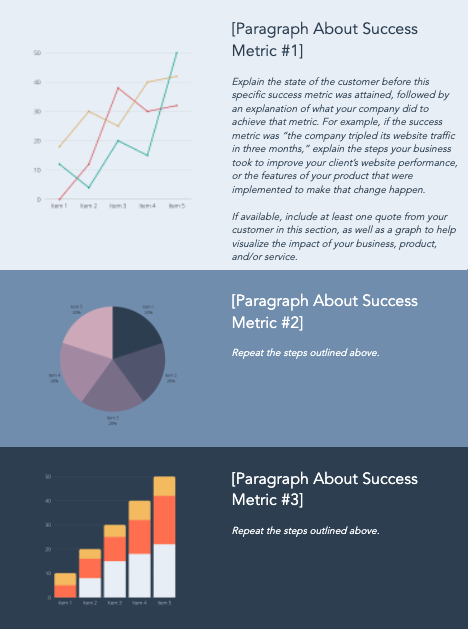
Do you have a specific product or service that you’re trying to sell, but not enough reviews or success stories? This Product Specific case study template will help.
This template relies less on metrics, and more on highlighting the customer’s experience and satisfaction. As you follow the template instructions, you’ll be prompted to speak more about the benefits of the specific product, rather than your team’s process for working with the customer.
4. Bold Social Media Business Case Study Template

You can find templates that represent different niches, industries, or strategies that your business has found success in — like a bold social media business case study template.
In this template, you can tell the story of how your social media marketing strategy has helped you or your client through collaboration or sale of your service. Customize it to reflect the different marketing channels used in your business and show off how well your business has been able to boost traffic, engagement, follows, and more.
5. Lead Generation Business Case Study Template

It’s important to note that not every case study has to be the product of a sale or customer story, sometimes they can be informative lessons that your own business has experienced. A great example of this is the Lead Generation Business case study template.
If you’re looking to share operational successes regarding how your team has improved processes or content, you should include the stories of different team members involved, how the solution was found, and how it has made a difference in the work your business does.
Now that we’ve discussed different templates and ideas for how to use them, let’s break down how to create your own case study with one.
- Get started with case study templates.
- Determine the case study's objective.
- Establish a case study medium.
- Find the right case study candidate.
- Contact your candidate for permission to write about them.
- Ensure you have all the resources you need to proceed once you get a response.
- Download a case study email template.
- Define the process you want to follow with the client.
- Ensure you're asking the right questions.
- Layout your case study format.
- Publish and promote your case study.
1. Get started with case study templates.
Telling your customer's story is a delicate process — you need to highlight their success while naturally incorporating your business into their story.
If you're just getting started with case studies, we recommend you download HubSpot's Case Study Templates we mentioned before to kickstart the process.
2. Determine the case study's objective.
All business case studies are designed to demonstrate the value of your services, but they can focus on several different client objectives.
Your first step when writing a case study is to determine the objective or goal of the subject you're featuring. In other words, what will the client have succeeded in doing by the end of the piece?
The client objective you focus on will depend on what you want to prove to your future customers as a result of publishing this case study.
Your case study can focus on one of the following client objectives:
- Complying with government regulation
- Lowering business costs
- Becoming profitable
- Generating more leads
- Closing on more customers
- Generating more revenue
- Expanding into a new market
- Becoming more sustainable or energy-efficient
3. Establish a case study medium.
Next, you'll determine the medium in which you'll create the case study. In other words, how will you tell this story?
Case studies don't have to be simple, written one-pagers. Using different media in your case study can allow you to promote your final piece on different channels. For example, while a written case study might just live on your website and get featured in a Facebook post, you can post an infographic case study on Pinterest and a video case study on your YouTube channel.
Here are some different case study mediums to consider:
Written Case Study
Consider writing this case study in the form of an ebook and converting it to a downloadable PDF. Then, gate the PDF behind a landing page and form for readers to fill out before downloading the piece, allowing this case study to generate leads for your business.
Video Case Study
Plan on meeting with the client and shooting an interview. Seeing the subject, in person, talk about the service you provided them can go a long way in the eyes of your potential customers.
Infographic Case Study
Use the long, vertical format of an infographic to tell your success story from top to bottom. As you progress down the infographic, emphasize major KPIs using bigger text and charts that show the successes your client has had since working with you.
Podcast Case Study
Podcasts are a platform for you to have a candid conversation with your client. This type of case study can sound more real and human to your audience — they'll know the partnership between you and your client was a genuine success.
4. Find the right case study candidate.
Writing about your previous projects requires more than picking a client and telling a story. You need permission, quotes, and a plan. To start, here are a few things to look for in potential candidates.
Product Knowledge
It helps to select a customer who's well-versed in the logistics of your product or service. That way, he or she can better speak to the value of what you offer in a way that makes sense for future customers.
Remarkable Results
Clients that have seen the best results are going to make the strongest case studies. If their own businesses have seen an exemplary ROI from your product or service, they're more likely to convey the enthusiasm that you want prospects to feel, too.
One part of this step is to choose clients who have experienced unexpected success from your product or service. When you've provided non-traditional customers — in industries that you don't usually work with, for example — with positive results, it can help to remove doubts from prospects.
Recognizable Names
While small companies can have powerful stories, bigger or more notable brands tend to lend credibility to your own. In fact, 89% of consumers say they'll buy from a brand they already recognize over a competitor, especially if they already follow them on social media.
Customers that came to you after working with a competitor help highlight your competitive advantage and might even sway decisions in your favor.
5. Contact your candidate for permission to write about them.
To get the case study candidate involved, you have to set the stage for clear and open communication. That means outlining expectations and a timeline right away — not having those is one of the biggest culprits in delayed case study creation.
Most importantly at this point, however, is getting your subject's approval. When first reaching out to your case study candidate, provide them with the case study's objective and format — both of which you will have come up with in the first two steps above.
To get this initial permission from your subject, put yourself in their shoes — what would they want out of this case study? Although you're writing this for your own company's benefit, your subject is far more interested in the benefit it has for them.
Benefits to Offer Your Case Study Candidate
Here are four potential benefits you can promise your case study candidate to gain their approval.
Brand Exposure
Explain to your subject to whom this case study will be exposed, and how this exposure can help increase their brand awareness both in and beyond their own industry. In the B2B sector, brand awareness can be hard to collect outside one's own market, making case studies particularly useful to a client looking to expand their name's reach.
Employee Exposure
Allow your subject to provide quotes with credits back to specific employees. When this is an option for them, their brand isn't the only thing expanding its reach — their employees can get their name out there, too. This presents your subject with networking and career development opportunities they might not have otherwise.
Product Discount
This is a more tangible incentive you can offer your case study candidate, especially if they're a current customer of yours. If they agree to be your subject, offer them a product discount — or a free trial of another product — as a thank-you for their help creating your case study.
Backlinks and Website Traffic
Here's a benefit that is sure to resonate with your subject's marketing team: If you publish your case study on your website, and your study links back to your subject's website — known as a "backlink" — this small gesture can give them website traffic from visitors who click through to your subject's website.
Additionally, a backlink from you increases your subject's page authority in the eyes of Google. This helps them rank more highly in search engine results and collect traffic from readers who are already looking for information about their industry.
6. Ensure you have all the resources you need to proceed once you get a response.
So you know what you’re going to offer your candidate, it’s time that you prepare the resources needed for if and when they agree to participate, like a case study release form and success story letter.
Let's break those two down.
Case Study Release Form
This document can vary, depending on factors like the size of your business, the nature of your work, and what you intend to do with the case studies once they are completed. That said, you should typically aim to include the following in the Case Study Release Form:
- A clear explanation of why you are creating this case study and how it will be used.
- A statement defining the information and potentially trademarked information you expect to include about the company — things like names, logos, job titles, and pictures.
- An explanation of what you expect from the participant, beyond the completion of the case study. For example, is this customer willing to act as a reference or share feedback, and do you have permission to pass contact information along for these purposes?
- A note about compensation.
Success Story Letter
As noted in the sample email, this document serves as an outline for the entire case study process. Other than a brief explanation of how the customer will benefit from case study participation, you'll want to be sure to define the following steps in the Success Story Letter.
7. Download a case study email template.
While you gathered your resources, your candidate has gotten time to read over the proposal. When your candidate approves of your case study, it's time to send them a release form.
A case study release form tells you what you'll need from your chosen subject, like permission to use any brand names and share the project information publicly. Kick-off this process with an email that runs through exactly what they can expect from you, as well as what you need from them. To give you an idea of what that might look like, check out this sample email:

8. Define the process you want to follow with the client.
Before you can begin the case study, you have to have a clear outline of the case study process with your client. An example of an effective outline would include the following information.
The Acceptance
First, you'll need to receive internal approval from the company's marketing team. Once approved, the Release Form should be signed and returned to you. It's also a good time to determine a timeline that meets the needs and capabilities of both teams.
The Questionnaire
To ensure that you have a productive interview — which is one of the best ways to collect information for the case study — you'll want to ask the participant to complete a questionnaire before this conversation. That will provide your team with the necessary foundation to organize the interview, and get the most out of it.
The Interview
Once the questionnaire is completed, someone on your team should reach out to the participant to schedule a 30- to 60-minute interview, which should include a series of custom questions related to the customer's experience with your product or service.
The Draft Review
After the case study is composed, you'll want to send a draft to the customer, allowing an opportunity to give you feedback and edits.
The Final Approval
Once any necessary edits are completed, send a revised copy of the case study to the customer for final approval.
Once the case study goes live — on your website or elsewhere — it's best to contact the customer with a link to the page where the case study lives. Don't be afraid to ask your participants to share these links with their own networks, as it not only demonstrates your ability to deliver positive results and impressive growth, as well.
9. Ensure you're asking the right questions.
Before you execute the questionnaire and actual interview, make sure you're setting yourself up for success. A strong case study results from being prepared to ask the right questions. What do those look like? Here are a few examples to get you started:
- What are your goals?
- What challenges were you experiencing before purchasing our product or service?
- What made our product or service stand out against our competitors?
- What did your decision-making process look like?
- How have you benefited from using our product or service? (Where applicable, always ask for data.)
Keep in mind that the questionnaire is designed to help you gain insights into what sort of strong, success-focused questions to ask during the actual interview. And once you get to that stage, we recommend that you follow the "Golden Rule of Interviewing." Sounds fancy, right? It's actually quite simple — ask open-ended questions.
If you're looking to craft a compelling story, "yes" or "no" answers won't provide the details you need. Focus on questions that invite elaboration, such as, "Can you describe ...?" or, "Tell me about ..."
In terms of the interview structure, we recommend categorizing the questions and flowing them into six specific sections that will mirror a successful case study format. Combined, they'll allow you to gather enough information to put together a rich, comprehensive study.
Open with the customer's business.
The goal of this section is to generate a better understanding of the company's current challenges and goals, and how they fit into the landscape of their industry. Sample questions might include:
- How long have you been in business?
- How many employees do you have?
- What are some of the objectives of your department at this time?
Cite a problem or pain point.
To tell a compelling story, you need context. That helps match the customer's need with your solution. Sample questions might include:
- What challenges and objectives led you to look for a solution?
- What might have happened if you did not identify a solution?
- Did you explore other solutions before this that did not work out? If so, what happened?
Discuss the decision process.
Exploring how the customer decided to work with you helps to guide potential customers through their own decision-making processes. Sample questions might include:
- How did you hear about our product or service?
- Who was involved in the selection process?
- What was most important to you when evaluating your options?
Explain how a solution was implemented.
The focus here should be placed on the customer's experience during the onboarding process. Sample questions might include:
- How long did it take to get up and running?
- Did that meet your expectations?
- Who was involved in the process?
Explain how the solution works.
The goal of this section is to better understand how the customer is using your product or service. Sample questions might include:
- Is there a particular aspect of the product or service that you rely on most?
- Who is using the product or service?
End with the results.
In this section, you want to uncover impressive measurable outcomes — the more numbers, the better. Sample questions might include:
- How is the product or service helping you save time and increase productivity?
- In what ways does that enhance your competitive advantage?
- How much have you increased metrics X, Y, and Z?
10. Lay out your case study format.
When it comes time to take all of the information you've collected and actually turn it into something, it's easy to feel overwhelmed. Where should you start? What should you include? What's the best way to structure it?
To help you get a handle on this step, it's important to first understand that there is no one-size-fits-all when it comes to the ways you can present a case study. They can be very visual, which you'll see in some of the examples we've included below, and can sometimes be communicated mostly through video or photos, with a bit of accompanying text.
Here are the sections we suggest, which we'll cover in more detail down below:
- Title: Keep it short. Develop a succinct but interesting project name you can give the work you did with your subject.
- Subtitle: Use this copy to briefly elaborate on the accomplishment. What was done? The case study itself will explain how you got there.
- Executive Summary : A 2-4 sentence summary of the entire story. You'll want to follow it with 2-3 bullet points that display metrics showcasing success.
- About the Subject: An introduction to the person or company you served, which can be pulled from a LinkedIn Business profile or client website.
- Challenges and Objectives: A 2-3 paragraph description of the customer's challenges, before using your product or service. This section should also include the goals or objectives the customer set out to achieve.
- How Product/Service Helped: A 2-3 paragraph section that describes how your product or service provided a solution to their problem.
- Results: A 2-3 paragraph testimonial that proves how your product or service specifically benefited the person or company and helped achieve its goals. Include numbers to quantify your contributions.
- Supporting Visuals or Quotes: Pick one or two powerful quotes that you would feature at the bottom of the sections above, as well as a visual that supports the story you are telling.
- Future Plans: Everyone likes an epilogue. Comment on what's ahead for your case study subject, whether or not those plans involve you.
- Call to Action (CTA): Not every case study needs a CTA, but putting a passive one at the end of your case study can encourage your readers to take an action on your website after learning about the work you've done.
When laying out your case study, focus on conveying the information you've gathered in the most clear and concise way possible. Make it easy to scan and comprehend, and be sure to provide an attractive call-to-action at the bottom — that should provide readers an opportunity to learn more about your product or service.
11. Publish and promote your case study.
Once you've completed your case study, it's time to publish and promote it. Some case study formats have pretty obvious promotional outlets — a video case study can go on YouTube, just as an infographic case study can go on Pinterest.
But there are still other ways to publish and promote your case study. Here are a couple of ideas:
Lead Gen in a Blog Post
As stated earlier in this article, written case studies make terrific lead-generators if you convert them into a downloadable format, like a PDF. To generate leads from your case study, consider writing a blog post that tells an abbreviated story of your client's success and asking readers to fill out a form with their name and email address if they'd like to read the rest in your PDF.
Then, promote this blog post on social media, through a Facebook post or a tweet.
Published as a Page on Your Website
As a growing business, you might need to display your case study out in the open to gain the trust of your target audience.
Rather than gating it behind a landing page, publish your case study to its own page on your website, and direct people here from your homepage with a "Case Studies" or "Testimonials" button along your homepage's top navigation bar.
Format for a Case Study
The traditional case study format includes the following parts: a title and subtitle, a client profile, a summary of the customer’s challenges and objectives, an account of how your solution helped, and a description of the results. You might also want to include supporting visuals and quotes, future plans, and calls-to-action.

Image Source
The title is one of the most important parts of your case study. It should draw readers in while succinctly describing the potential benefits of working with your company. To that end, your title should:
- State the name of your custome r. Right away, the reader must learn which company used your products and services. This is especially important if your customer has a recognizable brand. If you work with individuals and not companies, you may omit the name and go with professional titles: “A Marketer…”, “A CFO…”, and so forth.
- State which product your customer used . Even if you only offer one product or service, or if your company name is the same as your product name, you should still include the name of your solution. That way, readers who are not familiar with your business can become aware of what you sell.
- Allude to the results achieved . You don’t necessarily need to provide hard numbers, but the title needs to represent the benefits, quickly. That way, if a reader doesn’t stay to read, they can walk away with the most essential information: Your product works.
The example above, “Crunch Fitness Increases Leads and Signups With HubSpot,” achieves all three — without being wordy. Keeping your title short and sweet is also essential.
2. Subtitle

Your subtitle is another essential part of your case study — don’t skip it, even if you think you’ve done the work with the title. In this section, include a brief summary of the challenges your customer was facing before they began to use your products and services. Then, drive the point home by reiterating the benefits your customer experienced by working with you.
The above example reads:
“Crunch Fitness was franchising rapidly when COVID-19 forced fitness clubs around the world to close their doors. But the company stayed agile by using HubSpot to increase leads and free trial signups.”
We like that the case study team expressed the urgency of the problem — opening more locations in the midst of a pandemic — and placed the focus on the customer’s ability to stay agile.
3. Executive Summary

The executive summary should provide a snapshot of your customer, their challenges, and the benefits they enjoyed from working with you. Think it’s too much? Think again — the purpose of the case study is to emphasize, again and again, how well your product works.
The good news is that depending on your design, the executive summary can be mixed with the subtitle or with the “About the Company” section. Many times, this section doesn’t need an explicit “Executive Summary” subheading. You do need, however, to provide a convenient snapshot for readers to scan.
In the above example, ADP included information about its customer in a scannable bullet-point format, then provided two sections: “Business Challenge” and “How ADP Helped.” We love how simple and easy the format is to follow for those who are unfamiliar with ADP or its typical customer.
4. About the Company

Readers need to know and understand who your customer is. This is important for several reasons: It helps your reader potentially relate to your customer, it defines your ideal client profile (which is essential to deter poor-fit prospects who might have reached out without knowing they were a poor fit), and it gives your customer an indirect boon by subtly promoting their products and services.
Feel free to keep this section as simple as possible. You can simply copy and paste information from the company’s LinkedIn, use a quote directly from your customer, or take a more creative storytelling approach.
In the above example, HubSpot included one paragraph of description for Crunch Fitness and a few bullet points. Below, ADP tells the story of its customer using an engaging, personable technique that effectively draws readers in.

5. Challenges and Objectives

The challenges and objectives section of your case study is the place to lay out, in detail, the difficulties your customer faced prior to working with you — and what they hoped to achieve when they enlisted your help.
In this section, you can be as brief or as descriptive as you’d like, but remember: Stress the urgency of the situation. Don’t understate how much your customer needed your solution (but don’t exaggerate and lie, either). Provide contextual information as necessary. For instance, the pandemic and societal factors may have contributed to the urgency of the need.
Take the above example from design consultancy IDEO:
“Educational opportunities for adults have become difficult to access in the United States, just when they’re needed most. To counter this trend, IDEO helped the city of South Bend and the Drucker Institute launch Bendable, a community-powered platform that connects people with opportunities to learn with and from each other.”
We love how IDEO mentions the difficulties the United States faces at large, the efforts its customer is taking to address these issues, and the steps IDEO took to help.
6. How Product/Service Helped

This is where you get your product or service to shine. Cover the specific benefits that your customer enjoyed and the features they gleaned the most use out of. You can also go into detail about how you worked with and for your customer. Maybe you met several times before choosing the right solution, or you consulted with external agencies to create the best package for them.
Whatever the case may be, try to illustrate how easy and pain-free it is to work with the representatives at your company. After all, potential customers aren’t looking to just purchase a product. They’re looking for a dependable provider that will strive to exceed their expectations.
In the above example, IDEO describes how it partnered with research institutes and spoke with learners to create Bendable, a free educational platform. We love how it shows its proactivity and thoroughness. It makes potential customers feel that IDEO might do something similar for them.

The results are essential, and the best part is that you don’t need to write the entirety of the case study before sharing them. Like HubSpot, IDEO, and ADP, you can include the results right below the subtitle or executive summary. Use data and numbers to substantiate the success of your efforts, but if you don’t have numbers, you can provide quotes from your customers.
We can’t overstate the importance of the results. In fact, if you wanted to create a short case study, you could include your title, challenge, solution (how your product helped), and result.
8. Supporting Visuals or Quotes

Let your customer speak for themselves by including quotes from the representatives who directly interfaced with your company.
Visuals can also help, even if they’re stock images. On one side, they can help you convey your customer’s industry, and on the other, they can indirectly convey your successes. For instance, a picture of a happy professional — even if they’re not your customer — will communicate that your product can lead to a happy client.
In this example from IDEO, we see a man standing in a boat. IDEO’s customer is neither the man pictured nor the manufacturer of the boat, but rather Conservation International, an environmental organization. This imagery provides a visually pleasing pattern interrupt to the page, while still conveying what the case study is about.
9. Future Plans
This is optional, but including future plans can help you close on a more positive, personable note than if you were to simply include a quote or the results. In this space, you can show that your product will remain in your customer’s tech stack for years to come, or that your services will continue to be instrumental to your customer’s success.
Alternatively, if you work only on time-bound projects, you can allude to the positive impact your customer will continue to see, even after years of the end of the contract.
10. Call to Action (CTA)

Not every case study needs a CTA, but we’d still encourage it. Putting one at the end of your case study will encourage your readers to take an action on your website after learning about the work you've done.
It will also make it easier for them to reach out, if they’re ready to start immediately. You don’t want to lose business just because they have to scroll all the way back up to reach out to your team.
To help you visualize this case study outline, check out the case study template below, which can also be downloaded here .
You drove the results, made the connection, set the expectations, used the questionnaire to conduct a successful interview, and boiled down your findings into a compelling story. And after all of that, you're left with a little piece of sales enabling gold — a case study.
To show you what a well-executed final product looks like, have a look at some of these marketing case study examples.
1. "Shopify Uses HubSpot CRM to Transform High Volume Sales Organization," by HubSpot
What's interesting about this case study is the way it leads with the customer. This reflects a major HubSpot value, which is to always solve for the customer first. The copy leads with a brief description of why Shopify uses HubSpot and is accompanied by a short video and some basic statistics on the company.
Notice that this case study uses mixed media. Yes, there is a short video, but it's elaborated upon in the additional text on the page. So, while case studies can use one or the other, don't be afraid to combine written copy with visuals to emphasize the project's success.
2. "New England Journal of Medicine," by Corey McPherson Nash
When branding and design studio Corey McPherson Nash showcases its work, it makes sense for it to be visual — after all, that's what they do. So in building the case study for the studio's work on the New England Journal of Medicine's integrated advertising campaign — a project that included the goal of promoting the client's digital presence — Corey McPherson Nash showed its audience what it did, rather than purely telling it.
Notice that the case study does include some light written copy — which includes the major points we've suggested — but lets the visuals do the talking, allowing users to really absorb the studio's services.
3. "Designing the Future of Urban Farming," by IDEO
Here's a design company that knows how to lead with simplicity in its case studies. As soon as the visitor arrives at the page, he or she is greeted with a big, bold photo, and two very simple columns of text — "The Challenge" and "The Outcome."
Immediately, IDEO has communicated two of the case study's major pillars. And while that's great — the company created a solution for vertical farming startup INFARM's challenge — it doesn't stop there. As the user scrolls down, those pillars are elaborated upon with comprehensive (but not overwhelming) copy that outlines what that process looked like, replete with quotes and additional visuals.
4. "Secure Wi-Fi Wins Big for Tournament," by WatchGuard
Then, there are the cases when visuals can tell almost the entire story — when executed correctly. Network security provider WatchGuard can do that through this video, which tells the story of how its services enhanced the attendee and vendor experience at the Windmill Ultimate Frisbee tournament.
5. Rock and Roll Hall of Fame Boosts Social Media Engagement and Brand Awareness with HubSpot
In the case study above , HubSpot uses photos, videos, screenshots, and helpful stats to tell the story of how the Rock and Roll Hall of Fame used the bot, CRM, and social media tools to gain brand awareness.
6. Small Desk Plant Business Ups Sales by 30% With Trello
This case study from Trello is straightforward and easy to understand. It begins by explaining the background of the company that decided to use it, what its goals were, and how it planned to use Trello to help them.
It then goes on to discuss how the software was implemented and what tasks and teams benefited from it. Towards the end, it explains the sales results that came from implementing the software and includes quotes from decision-makers at the company that implemented it.
7. Facebook's Mercedes Benz Success Story
Facebook's Success Stories page hosts a number of well-designed and easy-to-understand case studies that visually and editorially get to the bottom line quickly.
Each study begins with key stats that draw the reader in. Then it's organized by highlighting a problem or goal in the introduction, the process the company took to reach its goals, and the results. Then, in the end, Facebook notes the tools used in the case study.
Showcasing Your Work
You work hard at what you do. Now, it's time to show it to the world — and, perhaps more important, to potential customers. Before you show off the projects that make you the proudest, we hope you follow these important steps that will help you effectively communicate that work and leave all parties feeling good about it.
Editor's Note: This blog post was originally published in February 2017 but was updated for comprehensiveness and freshness in July 2021.

Don't forget to share this post!
Related articles.

How to Market an Ebook: 21 Ways to Promote Your Content Offers
![customer service case study 7 Pieces of Content Your Audience Really Wants to See [New Data]](https://blog.hubspot.com/hubfs/most%20popular%20types%20of%20content.jpg)
7 Pieces of Content Your Audience Really Wants to See [New Data]
![customer service case study How to Write a Listicle [+ Examples and Ideas]](https://blog.hubspot.com/hubfs/listicle-1.jpg)
How to Write a Listicle [+ Examples and Ideas]

28 Case Study Examples Every Marketer Should See
![customer service case study What Is a White Paper? [FAQs]](https://blog.hubspot.com/hubfs/business%20whitepaper.jpg)
What Is a White Paper? [FAQs]

What is an Advertorial? 8 Examples to Help You Write One

How to Create Marketing Offers That Don't Fall Flat

20 Creative Ways To Repurpose Content

16 Important Ways to Use Case Studies in Your Marketing

11 Ways to Make Your Blog Post Interactive
Showcase your company's success using these free case study templates.
Marketing software that helps you drive revenue, save time and resources, and measure and optimize your investments — all on one easy-to-use platform
- Harvard Business School →
- Faculty & Research →
- July 2003 (Revised October 2018)
- HBS Case Collection
Starbucks: Delivering Customer Service
- Format: Print
- | Language: English
- | Pages: 20
About The Authors
Youngme Moon
John A. Quelch
Related work.
- Faculty Research
- Starbucks: Delivering Customer Service By: Youngme Moon and John Quelch
- Starting a Business
Our Top Picks
- Best Small Business Loans
- Best Business Internet Service
- Best Online Payroll Service
- Best Business Phone Systems
Our In-Depth Reviews
- OnPay Payroll Review
- ADP Payroll Review
- Ooma Office Review
- RingCentral Review
Explore More
- Business Solutions
- Entrepreneurship
- Franchising
- Best Accounting Software
- Best Merchant Services Providers
- Best Credit Card Processors
- Best Mobile Credit Card Processors
- Clover Review
- Merchant One Review
- QuickBooks Online Review
- Xero Accounting Review
- Financial Solutions
Human Resources
- Best Human Resources Outsourcing Services
- Best Time and Attendance Software
- Best PEO Services
- Best Business Employee Retirement Plans
- Bambee Review
- Rippling HR Software Review
- TriNet Review
- Gusto Payroll Review
- HR Solutions
Marketing and Sales
- Best Text Message Marketing Services
- Best CRM Software
- Best Email Marketing Services
- Best Website Builders
- Textedly Review
- Salesforce Review
- EZ Texting Review
- Textline Review
- Business Intelligence
- Marketing Solutions
- Marketing Strategy
- Public Relations
- Social Media
- Best GPS Fleet Management Software
- Best POS Systems
- Best Employee Monitoring Software
- Best Document Management Software
- Verizon Connect Fleet GPS Review
- Zoom Review
- Samsara Review
- Zoho CRM Review
- Technology Solutions
Business Basics
- 4 Simple Steps to Valuing Your Small Business
- How to Write a Business Growth Plan
- 12 Business Skills You Need to Master
- How to Start a One-Person Business
- FreshBooks vs. QuickBooks Comparison
- Salesforce CRM vs. Zoho CRM
- RingCentral vs. Zoom Comparison
- 10 Ways to Generate More Sales Leads
Southwest Airlines: A Case Study in Great Customer Service

Table of Contents
Southwest Airlines serves over 126 million passengers each year, provides service to 121 airports across 11 countries and has maintained its nearly 72,000-employee roster with no involuntary furloughs or layoffs in its history. In addition to its commercial and financial success, Southwest Airlines is known for its excellent customer service. Southwest has built an impeccable reputation by putting customers first and ensuring its employees are content and financially secure.
This model of exceptional customer service can be extrapolated to fit the needs of almost any industry if you employ strategies that work for your business. We’ll explain why Southwest is so successful as a company and a customer service provider to help other businesses understand and implement its tenets.
Southwest treats its employees well
Great customer service starts with happy employees. Southwest treats its employees well by backing individual employees’ decisions and providing everyone with quality employee benefits . For example, the company offers a 401(k) plan and matches contributions dollar-for-dollar up to 9.3 percent of the employee’s eligible earnings. It also offers a profit-sharing plan, an employee stock purchase plan, health and well-being rewards, as well as quality medical, vision and dental coverage.
In addition to benefits, Southwest also encourages professional development through in-person and online classes, mentorship programs, and even a Career Mobility Center that supports internal career advancement through advisement sessions and interview prep resources. The company also prioritizes community outreach, encouraging and incentivizing employees to give back to causes that matter to them.
Southwest makes excellent customer service its mission
According to a mission statement on Southwest’s website, “The mission of Southwest Airlines is dedication to the highest quality of Customer Service delivered with a sense of warmth, friendliness, individual pride and Company Spirit.”
Southwest outperforms competitors in customer service
In its last survey of the airline industry from 2018, the Temkin Group compared nine U.S. airlines on the quality of their customer experience – the sum of all a customer’s experiences and interactions with a brand. The strategy of focusing on customer experience is built around the needs of the individual customer over the lifetime of the customer-brand relationship.
The Temkin Group’s survey ranked each airline on the criteria of functionality (how well experiences meet customer needs), accessibility (how easy it is for customers to do what they want to do) and emotion (how customers feel about the experience).
Southwest Airlines earned the highest score every year the Temkin Experience Ratings were published from 2011 to 2018, except for 2015. In the most recent rankings, the company received the highest score in the airline industry, 76 percent – 10 percentage points higher than the industry average score of 66 percent.
Over the years, Southwest Airlines has maintained high ratings among customers, even amid a global pandemic and overall declines in passenger satisfaction. According to the 2023 J.D. Power North American Airline Satisfaction Study , Southwest ranked highest in customer satisfaction for a second consecutive year for the economy and basic economy segment.
How Southwest Airlines emphasizes the customer experience
Southwest Airlines takes the following crucial steps to prioritize the customer experience:
- Southwest offers multiple avenues for customer support. Customer experience is no longer just an in-person interaction or a phone call. It’s now online, in live chat and more. In addition to multiple phone numbers for different customer service issues, Southwest offers live chat (via mobile app), email and a self-help resource center, allowing multiple touch points and opportunities to delight customers .
- Southwest adapts to meet customers’ evolving expectations. The airline invested over $2 billion to improve the customer experience. From improved real-time travel communications to bag tracking to bolstered self-service options, Southwest proactively meets passenger needs to make traveling more convenient and comfortable.
- Southwest empowers employees. Southwest takes care of its employees, which, in turn, helps employees take care of its customers. Providing robust financial and wellness benefits and ongoing career development allows Southwest’s team to perform at its best and effectively support its customers.
How to provide excellent customer service
All businesses should strive to achieve Southwest’s exceptional customer service. However, many of its specific strategies are tailored to the airline industry and may not work for your organization. Here are a few additional methods any business can implement to give its customers the service they deserve.
1. Be responsive to issues.
Nothing is more frustrating than being put on hold for over an hour, especially if you’ve already paid for a product or service. Remember that your customer relationships don’t end after money has been exchanged. These relationships are long-term commitments that must be cultivated over time.
If you don’t have the time to answer calls all day, consider staffing your business with more agents or outsourcing customer service calls. Ensure all customer service reps and outsourced service agents use one of the best CRM software platforms to ensure consistency and informed help. You can also streamline your communication channels and preferences to accommodate as many customer inquiries as possible. For example, it’s easy to set up a chat feature or an FAQ page on your website to avoid being overwhelmed by calls.
With so many options available to help your customers, there’s no excuse for leaving them in the dark when they have an issue.
2. Communicate beyond complaints.
Responding to problems swiftly is vital to maintaining a high level of customer service, but communicating with your audience shouldn’t stop there. Starting a weekly email newsletter or using X (formerly Twitter) as a customer support channel are great ways to stay in touch with your base.
A simple “thank you for thinking of us” when a customer tags your brand on social media can go a long way. It’s a simple, cost-free measure to set your business apart as one that truly cares about customer service.
3. Get to know your customers.
Customers love a personalized experience because it makes them feel heard. However, to ensure the personalized experience stays positive, you should understand the customer’s wants and needs. Maintaining this mindset will help ensure the customer trusts you and your company in the long run.
Almost every customer service representative has some kind of script they must stick to, but there are opportunities to veer off-book and personalize the experience. You could ask customers what they’ve been up to lately or why they chose your company, or just find a way to make them laugh. If you’re willing to go that extra mile, it can be the difference between keeping a customer and losing them.
4. Keep a positive attitude.
When trying to keep a positive attitude toward the customer, it can help to inhabit a service persona. How you speak to your customers can sometimes be more important than what you say. This approach allows you to connect with the customer on an emotional level. You’ll understand their explicit needs and better understand their overall attitude toward you and the company. If you focus on positive thinking and a positive attitude, customers will likely respond in kind.
Danielle Fallon-O’Leary contributed to this article.

Get Weekly 5-Minute Business Advice
B. newsletter is your digest of bite-sized news, thought & brand leadership, and entertainment. All in one email.
Our mission is to help you take your team, your business and your career to the next level. Whether you're here for product recommendations, research or career advice, we're happy you're here!
How to write a case study — examples, templates, and tools

It’s a marketer’s job to communicate the effectiveness of a product or service to potential and current customers to convince them to buy and keep business moving. One of the best methods for doing this is to share success stories that are relatable to prospects and customers based on their pain points, experiences, and overall needs.
That’s where case studies come in. Case studies are an essential part of a content marketing plan. These in-depth stories of customer experiences are some of the most effective at demonstrating the value of a product or service. Yet many marketers don’t use them, whether because of their regimented formats or the process of customer involvement and approval.
A case study is a powerful tool for showcasing your hard work and the success your customer achieved. But writing a great case study can be difficult if you’ve never done it before or if it’s been a while. This guide will show you how to write an effective case study and provide real-world examples and templates that will keep readers engaged and support your business.
In this article, you’ll learn:
What is a case study?
How to write a case study, case study templates, case study examples, case study tools.
A case study is the detailed story of a customer’s experience with a product or service that demonstrates their success and often includes measurable outcomes. Case studies are used in a range of fields and for various reasons, from business to academic research. They’re especially impactful in marketing as brands work to convince and convert consumers with relatable, real-world stories of actual customer experiences.
The best case studies tell the story of a customer’s success, including the steps they took, the results they achieved, and the support they received from a brand along the way. To write a great case study, you need to:
- Celebrate the customer and make them — not a product or service — the star of the story.
- Craft the story with specific audiences or target segments in mind so that the story of one customer will be viewed as relatable and actionable for another customer.
- Write copy that is easy to read and engaging so that readers will gain the insights and messages intended.
- Follow a standardized format that includes all of the essentials a potential customer would find interesting and useful.
- Support all of the claims for success made in the story with data in the forms of hard numbers and customer statements.
Case studies are a type of review but more in depth, aiming to show — rather than just tell — the positive experiences that customers have with a brand. Notably, 89% of consumers read reviews before deciding to buy, and 79% view case study content as part of their purchasing process. When it comes to B2B sales, 52% of buyers rank case studies as an important part of their evaluation process.
Telling a brand story through the experience of a tried-and-true customer matters. The story is relatable to potential new customers as they imagine themselves in the shoes of the company or individual featured in the case study. Showcasing previous customers can help new ones see themselves engaging with your brand in the ways that are most meaningful to them.
Besides sharing the perspective of another customer, case studies stand out from other content marketing forms because they are based on evidence. Whether pulling from client testimonials or data-driven results, case studies tend to have more impact on new business because the story contains information that is both objective (data) and subjective (customer experience) — and the brand doesn’t sound too self-promotional.

Case studies are unique in that there’s a fairly standardized format for telling a customer’s story. But that doesn’t mean there isn’t room for creativity. It’s all about making sure that teams are clear on the goals for the case study — along with strategies for supporting content and channels — and understanding how the story fits within the framework of the company’s overall marketing goals.
Here are the basic steps to writing a good case study.
1. Identify your goal
Start by defining exactly who your case study will be designed to help. Case studies are about specific instances where a company works with a customer to achieve a goal. Identify which customers are likely to have these goals, as well as other needs the story should cover to appeal to them.
The answer is often found in one of the buyer personas that have been constructed as part of your larger marketing strategy. This can include anything from new leads generated by the marketing team to long-term customers that are being pressed for cross-sell opportunities. In all of these cases, demonstrating value through a relatable customer success story can be part of the solution to conversion.
2. Choose your client or subject
Who you highlight matters. Case studies tie brands together that might otherwise not cross paths. A writer will want to ensure that the highlighted customer aligns with their own company’s brand identity and offerings. Look for a customer with positive name recognition who has had great success with a product or service and is willing to be an advocate.
The client should also match up with the identified target audience. Whichever company or individual is selected should be a reflection of other potential customers who can see themselves in similar circumstances, having the same problems and possible solutions.
Some of the most compelling case studies feature customers who:
- Switch from one product or service to another while naming competitors that missed the mark.
- Experience measurable results that are relatable to others in a specific industry.
- Represent well-known brands and recognizable names that are likely to compel action.
- Advocate for a product or service as a champion and are well-versed in its advantages.
Whoever or whatever customer is selected, marketers must ensure they have the permission of the company involved before getting started. Some brands have strict review and approval procedures for any official marketing or promotional materials that include their name. Acquiring those approvals in advance will prevent any miscommunication or wasted effort if there is an issue with their legal or compliance teams.
3. Conduct research and compile data
Substantiating the claims made in a case study — either by the marketing team or customers themselves — adds validity to the story. To do this, include data and feedback from the client that defines what success looks like. This can be anything from demonstrating return on investment (ROI) to a specific metric the customer was striving to improve. Case studies should prove how an outcome was achieved and show tangible results that indicate to the customer that your solution is the right one.
This step could also include customer interviews. Make sure that the people being interviewed are key stakeholders in the purchase decision or deployment and use of the product or service that is being highlighted. Content writers should work off a set list of questions prepared in advance. It can be helpful to share these with the interviewees beforehand so they have time to consider and craft their responses. One of the best interview tactics to keep in mind is to ask questions where yes and no are not natural answers. This way, your subject will provide more open-ended responses that produce more meaningful content.
4. Choose the right format
There are a number of different ways to format a case study. Depending on what you hope to achieve, one style will be better than another. However, there are some common elements to include, such as:
- An engaging headline
- A subject and customer introduction
- The unique challenge or challenges the customer faced
- The solution the customer used to solve the problem
- The results achieved
- Data and statistics to back up claims of success
- A strong call to action (CTA) to engage with the vendor
It’s also important to note that while case studies are traditionally written as stories, they don’t have to be in a written format. Some companies choose to get more creative with their case studies and produce multimedia content, depending on their audience and objectives. Case study formats can include traditional print stories, interactive web or social content, data-heavy infographics, professionally shot videos, podcasts, and more.
5. Write your case study
We’ll go into more detail later about how exactly to write a case study, including templates and examples. Generally speaking, though, there are a few things to keep in mind when writing your case study.
- Be clear and concise. Readers want to get to the point of the story quickly and easily, and they’ll be looking to see themselves reflected in the story right from the start.
- Provide a big picture. Always make sure to explain who the client is, their goals, and how they achieved success in a short introduction to engage the reader.
- Construct a clear narrative. Stick to the story from the perspective of the customer and what they needed to solve instead of just listing product features or benefits.
- Leverage graphics. Incorporating infographics, charts, and sidebars can be a more engaging and eye-catching way to share key statistics and data in readable ways.
- Offer the right amount of detail. Most case studies are one or two pages with clear sections that a reader can skim to find the information most important to them.
- Include data to support claims. Show real results — both facts and figures and customer quotes — to demonstrate credibility and prove the solution works.
6. Promote your story
Marketers have a number of options for distribution of a freshly minted case study. Many brands choose to publish case studies on their website and post them on social media. This can help support SEO and organic content strategies while also boosting company credibility and trust as visitors see that other businesses have used the product or service.
Marketers are always looking for quality content they can use for lead generation. Consider offering a case study as gated content behind a form on a landing page or as an offer in an email message. One great way to do this is to summarize the content and tease the full story available for download after the user takes an action.
Sales teams can also leverage case studies, so be sure they are aware that the assets exist once they’re published. Especially when it comes to larger B2B sales, companies often ask for examples of similar customer challenges that have been solved.
Now that you’ve learned a bit about case studies and what they should include, you may be wondering how to start creating great customer story content. Here are a couple of templates you can use to structure your case study.
Template 1 — Challenge-solution-result format
- Start with an engaging title. This should be fewer than 70 characters long for SEO best practices. One of the best ways to approach the title is to include the customer’s name and a hint at the challenge they overcame in the end.
- Create an introduction. Lead with an explanation as to who the customer is, the need they had, and the opportunity they found with a specific product or solution. Writers can also suggest the success the customer experienced with the solution they chose.
- Present the challenge. This should be several paragraphs long and explain the problem the customer faced and the issues they were trying to solve. Details should tie into the company’s products and services naturally. This section needs to be the most relatable to the reader so they can picture themselves in a similar situation.
- Share the solution. Explain which product or service offered was the ideal fit for the customer and why. Feel free to delve into their experience setting up, purchasing, and onboarding the solution.
- Explain the results. Demonstrate the impact of the solution they chose by backing up their positive experience with data. Fill in with customer quotes and tangible, measurable results that show the effect of their choice.
- Ask for action. Include a CTA at the end of the case study that invites readers to reach out for more information, try a demo, or learn more — to nurture them further in the marketing pipeline. What you ask of the reader should tie directly into the goals that were established for the case study in the first place.
Template 2 — Data-driven format
- Start with an engaging title. Be sure to include a statistic or data point in the first 70 characters. Again, it’s best to include the customer’s name as part of the title.
- Create an overview. Share the customer’s background and a short version of the challenge they faced. Present the reason a particular product or service was chosen, and feel free to include quotes from the customer about their selection process.
- Present data point 1. Isolate the first metric that the customer used to define success and explain how the product or solution helped to achieve this goal. Provide data points and quotes to substantiate the claim that success was achieved.
- Present data point 2. Isolate the second metric that the customer used to define success and explain what the product or solution did to achieve this goal. Provide data points and quotes to substantiate the claim that success was achieved.
- Present data point 3. Isolate the final metric that the customer used to define success and explain what the product or solution did to achieve this goal. Provide data points and quotes to substantiate the claim that success was achieved.
- Summarize the results. Reiterate the fact that the customer was able to achieve success thanks to a specific product or service. Include quotes and statements that reflect customer satisfaction and suggest they plan to continue using the solution.
- Ask for action. Include a CTA at the end of the case study that asks readers to reach out for more information, try a demo, or learn more — to further nurture them in the marketing pipeline. Again, remember that this is where marketers can look to convert their content into action with the customer.
While templates are helpful, seeing a case study in action can also be a great way to learn. Here are some examples of how Adobe customers have experienced success.
Juniper Networks
One example is the Adobe and Juniper Networks case study , which puts the reader in the customer’s shoes. The beginning of the story quickly orients the reader so that they know exactly who the article is about and what they were trying to achieve. Solutions are outlined in a way that shows Adobe Experience Manager is the best choice and a natural fit for the customer. Along the way, quotes from the client are incorporated to help add validity to the statements. The results in the case study are conveyed with clear evidence of scale and volume using tangible data.

The story of Lenovo’s journey with Adobe is one that spans years of planning, implementation, and rollout. The Lenovo case study does a great job of consolidating all of this into a relatable journey that other enterprise organizations can see themselves taking, despite the project size. This case study also features descriptive headers and compelling visual elements that engage the reader and strengthen the content.
Tata Consulting
When it comes to using data to show customer results, this case study does an excellent job of conveying details and numbers in an easy-to-digest manner. Bullet points at the start break up the content while also helping the reader understand exactly what the case study will be about. Tata Consulting used Adobe to deliver elevated, engaging content experiences for a large telecommunications client of its own — an objective that’s relatable for a lot of companies.
Case studies are a vital tool for any marketing team as they enable you to demonstrate the value of your company’s products and services to others. They help marketers do their job and add credibility to a brand trying to promote its solutions by using the experiences and stories of real customers.
When you’re ready to get started with a case study:
- Think about a few goals you’d like to accomplish with your content.
- Make a list of successful clients that would be strong candidates for a case study.
- Reach out to the client to get their approval and conduct an interview.
- Gather the data to present an engaging and effective customer story.
Adobe can help
There are several Adobe products that can help you craft compelling case studies. Adobe Experience Platform helps you collect data and deliver great customer experiences across every channel. Once you’ve created your case studies, Experience Platform will help you deliver the right information to the right customer at the right time for maximum impact.
To learn more, watch the Adobe Experience Platform story .
Keep in mind that the best case studies are backed by data. That’s where Adobe Real-Time Customer Data Platform and Adobe Analytics come into play. With Real-Time CDP, you can gather the data you need to build a great case study and target specific customers to deliver the content to the right audience at the perfect moment.
Watch the Real-Time CDP overview video to learn more.
Finally, Adobe Analytics turns real-time data into real-time insights. It helps your business collect and synthesize data from multiple platforms to make more informed decisions and create the best case study possible.
Request a demo to learn more about Adobe Analytics.
https://business.adobe.com/blog/perspectives/b2b-ecommerce-10-case-studies-inspire-you
https://business.adobe.com/blog/basics/business-case
https://business.adobe.com/blog/basics/what-is-real-time-analytics


- Free Resources

5 mini case studies about understanding and serving the customer

This article was originally published in the MarketingSherpa email newsletter .
Mini Case Study #1: 34% increase in conversion for powdered health drink company by helping customers come to their own conclusions
A single-product company that sells high-quality, all-natural, powdered health drinks engaged MECLABS Institute to help better understand their potential customers and increase the conversion rate of prospects reaching the homepage.
The original homepage took a claims-driven approach – it provided several bold statements about what the product would do for a customer with no information about the product to help the customer understand why it would work for them. Here is a look at the upper left of the original homepage.
Creative Sample #1: Upper left of original homepage for health drink company

The MECLABS team created a version of the homepage that took a conclusion-driven approach – instead only trying to convince potential customers with only bold claims about the product, the homepage copy included information about the product to help customers understand why the product would help them.
Creative Sample #2: Upper left of treatment homepage for health drink company

The team tested this version as the treatment against the original homepage (the control) to help better understand what communication style customers would respond to.
The treatment generated a 34% increase in conversion rate.
This experiment highlights a classic disconnect between customers and marketers. If you work in a company or with a client, you have intimate knowledge of the product and believe in its effectiveness. You spend all day thinking about it. You personally know some of the people who designed it. Your paycheck depends on the success of the product.
A customer does not have this same understanding or belief in the product. They have a significant gap in their knowledge about your product. Bold claims alone are not enough to close that gap. They have to understand why the product will work and come to their own conclusions about the company’s ability to deliver on its promises.
You can learn more about this experiment in The Conversion Heuristic Analysis: Overcoming the prospect’s perception gap from MarketingExperiments (MarketingSherpa’s sister publication).
Mini Case Study #2: Bags company increases conversion 191% by adding clarity to homepage
“I'm the CEO of Doubletake , a tennis and pickleball bag company, but I spent the majority of my career focused on messaging and research, consulting as a strategist for top brands for the last 10 plus years, and in-house prior to that. I'm almost embarrassed that I have this example to share, but I thankfully came to my senses!,” Shawna Gwin Krasts told me.
“It is interesting that crafting messaging/copy for products that aren't ‘your baby’ is so much easier – there is just more distance to see it for what it is. If this wasn't so near and dear to my heart, I would have caught it in a second.”
The team launched its homepage with only the headline “Sports Meets Style” over a photo of a bag. The headline was meant to differentiate the brand from competitors that were either only sporty or fashionable. Below the headline was a call-to-action (CTA) button with the word “shop.”
Creative Sample #3: Previous homepage copy for bag company

Internally it seemed obvious that the company sells tennis and pickleball bags since a bag was in the photo.
But they came to realize that it might not be as clear to website visitors. So the team added the subhead “Gorgeous Yet Functional Tennis and Pickleball Bags.” They also added the word “bags” to the CTA so it read “shop bags.”
Creative Sample #4: New homepage copy for bag company

These simple changes increased the website's conversion rate by 191%.
“It is so important for marketers to get out of their own heads,” Krasts said. “I suppose this is why I struggle with messaging so much for Doubletake. I am the target customer – I have the answers in my head and I suppose my natural curiosity isn't as strong. But clearly, I also have to remember that I've seen my homepage 10,000 more times than my customers, which means things that seem obvious to me, like the fact that Doubletake is a tennis brand not a reseller, might not be obvious.”
Mini Case Study #3: Online motorcycle gear retailer doubles conversion with personalized emails
There are ways to better tap into what customers perceive as valuable built into certain marketing channels. Email marketing is a great example. Marketers can build off information they have on the customer to send more relevant emails with information and products the customer is more likely to value.
"Very early in my marketing career I was taught, 'You are not the target audience' and told to try to see things from my customer's perspective. Empathizing with customers is a good start towards seeing products from the customers' perspective, but marketers really need to focus on quantifiable actions that can help identify customers' needs. That means continuous testing across messaging, price points, packaging, and every other aspect of a product. This is where personalization can really shine. Every time a marketer personalizes a message, it brings them closer to their customer and closes that gap," said Gretchen Scheiman, VP of Marketing, Sailthru.
For example, 80% of the email messages RevZilla sent were generic. But the website sells motorcycle parts and gear to a wide range of riders, each with their own preference in brand and riding style. The online motorcycle gear retailer partnered with Sailthru to better connect with customer motivations. The team started by upgrading the welcome series for new customers by personalizing the email messages based on the customers’ purchases and preferences.
The company has tested and added many new triggers to the site, and now has 177 different automation journeys that include triggers for browse and cart abandonment as well as automations for different product preferences, riding styles and manufacturer preferences.
The conversion rate from personalized email is double what RevZilla was getting for generic batch-and-blast sends. Automated experiences now account for 40% of email revenue. Triggered revenue is up 22% year-over-year and site traffic from triggers has increased 128% year-over-year.
"Customizing the buyer journey isn't about one long flow, but about lots of little trigger points and tests along the way. For any marketer that is intimidated about getting started with personalization, it's important to realize that it's more like a lot of small building blocks that create a whole experience. We started with a custom welcome series using testing and built from there. We're still adding new tests and new trigger points, but it's with the same concept that we started with,” said Andrew Lim, Director of Retention Marketing, RevZilla.
Mini Case Study #4: Pet protection network increases revenue 53% thanks to survey feedback
Huan makes smart tags for pets to help owners find their pets if they go missing. Initially, the company focused on the technical features in its homepage copy. For example, the tags don’t emit harmful radiation, are water-resistant and have a replaceable one-year battery.
From customer feedback surveys, the team discovered that customers purchased the product because they were worried they wouldn’t be able to find their pet if the pet went missing. This discovery prompted the team to change its messaging.
The new messaging on the homepage read, “Keep your pet safe and prevent heartbreak. Huan Smart Tags help you find your missing pet automatically.”
Revenue increased 53% increase following the change in messaging. “We immediately saw an increase in engagement on our website, with a lower bounce rate, higher click-through rate and a higher conversion rate. There were also a few people who messaged us on social media saying how our new message resonated with them,” said Gilad Rom, Founder, Huan.
Mini Case Study #5: Talking to new customers leads SaaS to change strategy, increase sales 18%
When Chanty launched, the marketing messages focused on pricing since the Saas company is 50% less expensive than the best-known competitor. However, when the team started talking to customers, they discovered most people had switched from the competitor for different reasons – ease of use, better functionalities in the free plan, better experience with the customer support team, and a better mobile app.
The team changed its marketing to focus around these product attributes and only listed pricing in the end as an additional benefit.
“It turned out that this was the way to go because we attracted people who wanted a better experience, rather than just customers who wanted to save money. After six months of implementing this new marketing and sales strategy, our sales grew by 18%,” said Jane Kovalkova, Chief Marketing Officer, Chanty.
Related resources
The Prospect’s Perception Gap: How to bridge the dangerous gap between the results we want and the results we have
Customer-First Marketing: Understanding customer pain and responding with action
Marketing Research Chart: How customer understanding impacts satisfaction
Improve Your Marketing

Join our thousands of weekly case study readers.
Enter your email below to receive MarketingSherpa news, updates, and promotions:
Note: Already a subscriber? Want to add a subscription? Click Here to Manage Subscriptions
Get Better Business Results With a Skillfully Applied Customer-first Marketing Strategy

The customer-first approach of MarketingSherpa’s agency services can help you build the most effective strategy to serve customers and improve results, and then implement it across every customer touchpoint.

Get headlines, value prop, competitive analysis, and more.
Marketer Vs Machine

Marketer Vs Machine: We need to train the marketer to train the machine.
Free Marketing Course

Become a Marketer-Philosopher: Create and optimize high-converting webpages (with this free online marketing course)
Project and Ideas Pitch Template

A free template to help you win approval for your proposed projects and campaigns
Six Quick CTA checklists

These CTA checklists are specifically designed for your team — something practical to hold up against your CTAs to help the time-pressed marketer quickly consider the customer psychology of your “asks” and how you can improve them.
Infographic: How to Create a Model of Your Customer’s Mind

You need a repeatable methodology focused on building your organization’s customer wisdom throughout your campaigns and websites. This infographic can get you started.
Infographic: 21 Psychological Elements that Power Effective Web Design

To build an effective page from scratch, you need to begin with the psychology of your customer. This infographic can get you started.
Receive the latest case studies and data on email, lead gen, and social media along with MarketingSherpa updates and promotions.
- Your Email Account
- Customer Service Q&A
- Search Library
- Content Directory:
Questions? Contact Customer Service at [email protected]
© 2000-2024 MarketingSherpa LLC, ISSN 1559-5137 Editorial HQ: MarketingSherpa LLC, PO Box 50032, Jacksonville Beach, FL 32240
The views and opinions expressed in the articles of this website are strictly those of the author and do not necessarily reflect in any way the views of MarketingSherpa, its affiliates, or its employees.
- Customer Experience
- The Wire Blog
- Customer Service
3 Bad Customer Service Case Studies

Find the Speed You Need! Talk with an Adviser Today!
833-607-3009
According to the Harvard Business Review , simple actions, such as responding to tweets quickly, can increase the amount of money people are willing to pay doing business with an organization. Quality customer service builds loyalty and increases profits. Sometimes, however, even major brands have moments when their service goals go horribly wrong, teaching lessons for everyone else. The three bad customer service incidents below have recently sent major brands scrambling to preserve their image. Here's what we all can learn from their mistakes.
An Air Transat flight sat on the tarmac for hours without service
In July 2017, passengers aboard two Air Transat flights were diverted to Ottawa. While the airline had no control over the diversion itself, they had a responsibility for the fair treatment of their passengers following landing. Yet passengers reported being stranded on the tarmac for over four hours, on one flight without any food, air conditioning, or water. This incident caused at least one passenger to call 911 in an effort to force the airline to act.
Following the incident, the airline was fined and held responsible by the Canadian Transportation Agency. During the hearing, however, customers and the press noted that the airline and airport continually came up with excuses and tried to blame each other, which led customers to say they will not fly with Air Transat again.
Lesson to learn
Air Transat didn’t just make a mistake when they failed to provide comfort and necessities to their customers during the unexpected delay on the tarmac, they failed to take responsibility for their actions or make proper amends with their customers. Mistakes and incidents can happen to any business, but how you respond to the issue and treat your customers will have a lasting impact. Refusing to accept responsibility or focusing solely on the bottom line to the detriment of the customers can cause serious harm to your brand.
T-Mobile changed a customer’s name on their account to “Idiot”
T-Mobile had a customer calling about a billing issue with his new phone. When he didn’t get the desired help, he decided to reach the phone carrier through Twitter. Although most people would agree that customer service can be a very challenging job, the T-Mobile team certainly could have handled the situation more appropriately. The rep dealing with the issue apparently changed the customer’s name to “Idiot,” which the customer saw the next time he logged into his account. He posted his account of the incident online, which reasonably led to poor press for T-Mobile .
Providing customer service can make many people frustrated enough to scream. What is not acceptable, however, is doing anything that could get back to the customer. Brands should work to provide excellent service, even behind the scenes, to create an outstanding experience for customers. It’s important to have the right team with the right training to handle customer issues with grace and diplomacy. It’s not about the customer always being right – but the customer always deserves your respect.
Apple reduced the speed of their older devices
Apple decided to slow down their older devices without telling their customers. Although they may have had an understandable reason for this action, their failure to notify customers led to outrage among users.
Apple claimed the action was taken to preserve the battery life in the older phones. While this might have been true, it was the lack of transparency that angered customers. The brand ended up apologizing to customers and offering discounted battery replacements.
Despite good intentions, if your actions negatively impact customers, you need to err on the side of transparency. If Apple had let customers know upfront that their devices would eventually slow down and why, it would have been less of a scandal. Instead, since customers discovered it on their own, it left them feeling suspicious about what else the company isn’t telling them. Trust is one of the most important qualities in your relationship with customers. Don’t give them any reason to doubt you.
Customer service remains a critical component of any successful brand. If you want to grow, you need to focus on outstanding customer care during every interaction. Bad customer service will cost you more than just the customer directly involved, so take the lessons learned from these recent disasters and make sure you don’t make the same mistakes.
The trends, insights, and solutions you need to grow your business .
By signing up, you’re subscribing to our monthly email newsletter, The Wire. You may unsubscribe at any time. Your information stays safe with us. Learn more about our privacy policy .

Related Articles

A Strategic Guide to cultivating a brand that sells A beginner's guide designed to arm you with the information you need to develop an authentic brand that resonates with customers and connects to the community
When you submit this form, you’ll receive our monthly newsletter, The Wire , which contains trends, insights, and solutions you need to grow your business . We’ll also email you product information and special offers. You may unsubscribe at any time.
Your information stays safe with us. Learn more about our privacy policy.

Word on the Street
What do business customers like about Sparklight Business?
Testimonials

New Low Pricing!
Our lowest pricing ever on business phone plans plus other great deals.
Start Saving

Powerful New Products
Shared fiber, managed wireless and two new business phone solutions.
See the Latest
Get more done in less time
Call us at (833) 607-3009 Or fill out this form and we’ll be in touch.
Call us at (833) 607-3009
Or fill out this form and we'll be in touch, schedule my consultation.
Call Now (833) 607-3009
Or fill out the form to be contacted by an adviser.
We respect your privacy. We promise to NEVER sell your information.
Speeds up to 1 Gig | Unlimited data included | Superior reliability
REQUEST A CALLBACK
We aren't online right now, please leave a message.
Did you find what you were looking for?
- Business Sales
- Business Care
- Tech Support
(833) 607-3009
Humans are reinventing the consumer goods and services industry
In the age of digital commerce, it is hard to predict what consumers will buy – and why, when and where they buy it. To stay ahead of uncertainty, think like a consumer and focus on building strong relationships.
Consumer goods and services now
of consumer goods executives aspire to set a new standard for the industry – or even outside of it
of executives believe consumers are changing faster than they can change their businesses
of consumer goods companies identify the omni-connected consumer as a top priority
of companies are prioritizing integrated business planning over demand-driven inventory supply
How to reinvent consumer goods and services
Deliver winning consumer and customer experiences.

Access powerful insights by tapping into data
Drive profitable growth with digital commerce transformation.

The generative AI era
Do well by doing good, generate enduring, long-term sustainable value.
By directly involving humans—and their data—in the creation and orchestration of holistic consumer experiences, companies can meet changing consumer demands at the speed of life.
Drive loyalty
Unparalleled consumer relevance and intimacy drives loyalty.
Improve accuracy
Massively reduce risk while improving launch accuracy.
Data is everywhere but remains an untapped resource. Leading CPG’s leverage data and analytics intelligence to seize value creation opportunities.
Innovate and grow
Leverage data to create new product and investment ideas.
Improve consumer engagement
Dig into data to create hyper-personalized marketing content that will boost conversion.
Adoption of digital commerce is both material and ubiquitous for consumers and customers alike. This creates a big opportunity to capture the full potential of a market that’s poised to grow by 56% over the next three years.
Grow consumer and customer lifetime value
Provide differentiated, personalized and consistent experiences across channels that build loyalty.
Build rich insights
Combine business and ESG data across multiple channels and build insights into consumer and customer needs to gain competitive advantage.
Deliver at scale and pace
Build operating model agility by implementing the right commerce infrastructure and operations for efficient orchestration across channels and easy integration of new channels.
Reduce costs
Drive cost reduction, sustainability outcomes, and improved efficiencies by taking an integrated, ethical end to end approach to digital commerce that eliminates inefficiencies and reduces duplication.
Generative AI brings opportunities for CPGs to reinvent across the value chain and transform ways of working.
AI can help capture consumer trends faster and better, fueling new product development.
Boost conversion
Ignite engagement with hyper-personalized content and a consumer-of-one approach.
Unlock people’s potential
Blend process, automation, and real human experience to rethink work structures and craft new roles for new levels of productivity.
Sustainability is a key force for change and drives long-term growth and viability—and it’s good for business. In the future, we will not talk about “sustainable business” sustainability will be “business as usual.”
Save on cost
Outperform on financial returns and improve risk management (for example, soap concentrates are higher-margin and better for the environment).
Deepen relationships
Embracing sustainability translates into improved retention and employee satisfaction, deeper supplier and partner collaboration, and differential brand growth.
Consumers have the power—and they want to see sustainability in every product or purchase option. Rethink processes, technology, and tools with a sustainability lens to reveal holistic value and leapfrog competition.
Less than 20%
Increase productivity.
Rising input costs combined with higher inflation erodes consumer spending and hurts confidence. Enhance SG&A by 15-20% and improve working capital by 10-20% by expanding workforce productivity with end-to-end process transformation.
Grow revenue
CPGs are worried about optimizing and managing working capital amid recessionary pressure while maintaining sufficient liquidity to operate. Grow revenue by 1-2% by aligning investment to strategic priorities and future value pools.
Segments we support
From planting to processing and even connected cows, enable the entire food value chain with 5G technology.
Use data and AI to create beautifully connected experiences that meet demand for personalized services.
Design, build, distribute and scale for a sector at the center of society.
Feed changing tastes and deliver delicious, scalable food experiences.
Enable smarter, more connected lives—from personal care and hygiene to home care products and appliances.
What’s trending in consumer goods and services

Information overload is impacting people’s confidence in their decisions — big or small. AI tools can help companies deliver hyper-personalized experiences that cut through the noise, deepening loyalty in the process.

Change is here to stay for consumer goods companies, and the pace will only accelerate. Brands need a depth of consumer understanding and an unparalleled agility to move at the speed of life.

Five imperatives the C-suite must address to reinvent in the age of generative AI.

Lion, an Australian and New Zealand beverage company, digitally transformed by migrating to AWS, enabling efficiency, agility, sustainable growth, real-time insights, and an enhanced customer experience.

Beauty is undergoing fundamental change, driven by consumers seeking science-led products that enhance health and wellness from the inside out. Growth requires a level of reinvention that will ultimately redefine the industry.

Gen AI will transform entire value chains—and the very nature of work itself. Leaders need to lead and learn in new ways to drive business performance and more productive, creative and meaningful work for everyone.

How resilient consumers are adapting in an era of volatility.

Reimagining talent mobility
Partners in change

Helping you unlock the value of your SAP application portfolio with the power of intelligence, innovation and industry.

Reimagining human experiences that reignite growth and accelerate the path to value

The largest global Microsoft practice. Eighteen-time Microsoft Global Alliance SI Partner of the Year. Powered by Avanade. Runs on Microsoft.

Unleash empowering human-centric design and Google’s innovative tech.

Unleash the power of unforgettable customer experiences.
Awards and recognition
Hfs ranks accenture no. 1 tech services provider to retail and consumer packaged goods companies, a leader in digital strategy consulting services - idc, for fourth consecutive year, named a leader in data and analytics services - everest, our leaders.

Oliver Wright
Senior Managing Director – Consumer Goods & Services, Global Lead

Marc van der Net
Managing Director – Consumer Goods & Services Lead, EMEA

Senior Managing Director – Consumer Goods & Services Lead, North America

Mauro Rubin
Managing Director – Consumer Goods & Services Lead, Growth Markets
Grow your careers at the heart of change

Salesforce is closed for new business in your area.
- SUGGESTED TOPICS
- The Magazine
- Newsletters
- Managing Yourself
- Managing Teams
- Work-life Balance
- The Big Idea
- Data & Visuals
- Reading Lists
- Case Selections
- HBR Learning
- Topic Feeds
- Account Settings
- Email Preferences
Customer Experience in the Age of AI
- David C. Edelman
- Mark Abraham

Companies across all industries are putting personalization at the center of their enterprise strategies. For example, Home Depot, JPMorgan Chase, Starbucks, and Nike have publicly announced that personalized and seamless omnichannel experiences are at the core of their corporate strategy. We are now at the point where competitive advantage will be based on the ability to capture, analyze, and utilize personalized customer data at scale and on how a company uses AI to understand, shape, customize, and optimize the customer journey. The obvious winners have been large tech companies, which have embedded these capabilities in their business models. But challenger brands, such as sweetgreen in restaurants and Stitch Fix in apparel, have designed transformative first-party, data-driven experiences as well.
The authors explore how cutting-edge companies use what they call intelligent experience engines to assemble high-quality customer experiences. Although building one can be time-consuming, expensive, and technologically complex, the result allows companies to deliver personalization at a scale that could only have been imagined a decade ago.
The case for building “intelligent experience engines”
Idea in Brief
The reality.
A personalized customer experience has become the basis for competitive advantage.
The Problem
However, providing personalization requires more than just a technological fix.
The Solution
Businesses must design intelligent experience engines, which assemble high-quality, end-to-end customer experiences using AI powered by customer data.
Brinks is a 163-year-old business well-known for its fleet of armored trucks. The company also licenses its brand to a lesser-known, independently operated sister company, Brinks Home. The Dallas-based smart-home-technology business has struggled to gain brand recognition commensurate with the Brinks name. It competes against better-known systems from ADT, Google Nest, and Ring, and although it has earned stellar reviews from industry analysts and customers, its market share is only 2%. But its systems have generated a wealth of product usage information; its call centers have accumulated voluminous historical customer-level transaction data; and its field reps have been gathering competitive data since it began operations, in 1994.
- David C. Edelman is an executive adviser and a senior lecturer at Harvard Business School.
- Mark Abraham is a managing director and a senior partner at Boston Consulting Group.
Partner Center

IMAGES
VIDEO
COMMENTS
Learn how JetBlue, Zappos, LEGO, and WPManageNinja handled customer service challenges with creativity and care. See how they used social media, personal touch, and custom solutions to impress their customers and boost their brand reputation.
The Importance of Effective Customer Service; Case Study 1: Resolving a Product Quality Issue; Case Study 2: Handling a Difficult Customer; Case Study 3: Going Above and Beyond for a Customer; Case Study 4: Turning a Negative Review into a Positive Experience. The negative feedback received by the business; The steps taken to address the ...
Case Study: Solution for World Class Travel Customer Experience; Webinar: How Spirit Airlines is Improving the Guest ... In fact, consumers are willing to spend 17 percent more with companies that deliver great customer service, according to American Express. Unfortunately, it's true that bad news travels faster than good news, especially in ...
As more and more customer transactions occur virtually, the quality of online help desks and customer service support is becoming an essential differentiator for companies. An estimated 73% of consumers say a good experience is critical in influencing their brand loyalties. Customer satisfaction directly impacts the bottom line, too, as 84% of ...
4 interesting customer service case studies Quick Heal and Kayako. Here's the first interesting customer service case study from Kayako. There was a company called Quick Heal Technologies which was a provider of internet security tools and anti-virus software. They had millions of global users, but they were struggling to deliver outstanding ...
Anthony K. Tjan. A basic prerequisite for business success is to know — really know — your customers. There's a variety of traditional research methods aimed at better understanding ...
Instead, T-Mobile relies on colocated, collaborative teams of reps who manage specific accounts in a given locale, with a focus on autonomous problem solving. Reps get more-comprehensive training ...
While digital solutions and the shift to self-service channels will solve many of these challenges, they aren't quite reaching the goal. For most organizations, the vast majority of digital customer contacts require assistance, and only 10 percent of newly built digital platforms are fully scaled or adopted by customers.
Firms increasingly deploy self-service technologies (SSTs) to manage customer interfaces that are inherently stressful. For example, patients may be asked to use kiosks to check themselves into hospitals. This study finds that customer anxiety during SST transactions can reduce customers' trust in the service provider.
Learn how to create customer case studies that showcase your product or service's benefits and results. See examples from Zoom, Hootsuite, and AT&T and get tips on format, interview questions, and target audience.
Zappos, the online shoe retailer, is legendary for its employee culture and customer service. Paying employees to quit; offering customers free shipping both ways and a year to make returns; and ...
A case study on customer service can only be done by requesting feedback from the consumer/customer. A company simply cannot look at the data to find out why they are losing customer/consumer base ...
Discover the success story of Zappos, the online shoe retailer that rose to fame with its exceptional customer service and unique company culture. Read this in-depth case study to learn about Zappos' journey from its early days to becoming one of the top e-commerce companies in the world.
5. Contact your candidate for permission to write about them. To get the case study candidate involved, you have to set the stage for clear and open communication. That means outlining expectations and a timeline right away — not having those is one of the biggest culprits in delayed case study creation.
Moon, Youngme, and John Quelch. "Starbucks: Delivering Customer Service." Harvard Business School Case 504-016, July 2003. (Revised October 2018 ...
ADT Security Service Boosts Sales By 17% Using Tidio. Learn about the benefits ADT Security Service gained from using Tidio. Discover how it increased the conversion rate and customer satisfaction since implementing the customer service tool. Read more.
Southwest Airlines serves over 126 million passengers each year, provides service to 121 airports across 11 countries and has maintained its nearly 72,000-employee roster with no involuntary furloughs or layoffs in its history. In addition to its commercial and financial success, Southwest Airlines is known for its excellent customer service.
Case study examples. While templates are helpful, seeing a case study in action can also be a great way to learn. Here are some examples of how Adobe customers have experienced success. Juniper Networks. One example is the Adobe and Juniper Networks case study, which puts the reader in the customer's shoes.
A case study is a compelling narrative that showcases how your product or service has positively impacted a real business or individual. Case studies delve into your customer's challenges, how your solution addressed them and the quantifiable results they achieved.
Customer Service is a groundbreaking study on the elements that create viral customer service experiences. The research was conducted over three years in seven North American and Asian/South Pacific countries, and released in 2016. The results help provide clear direction for organizations that are looking to create customer service experiences ...
Wrap Up the Interview and Include Referral Questions. At the end of your marketing case study interview, ask some general questions about customer satisfaction and relationship management. You can use these to conclude the case study. This section of the interview is also likely to generate some potential customer quotes you can use in your ...
Mini Case Study #5: Talking to new customers leads SaaS to change strategy, increase sales 18%. When Chanty launched, the marketing messages focused on pricing since the Saas company is 50% less expensive than the best-known competitor.
Here are 21 common customer service scenarios with example responses you can use to improve your customer service skills: 1. Suggestion for improvement. Sometimes, customers contact the customer service department to suggest ways to improve the product they've purchased. When you answer this question, you can offer to communicate the request to ...
3 Bad Customer Service Case Studies. According to the Harvard Business Review, simple actions, such as responding to tweets quickly, can increase the amount of money people are willing to pay doing business with an organization. Quality customer service builds loyalty and increases profits. Sometimes, however, even major brands have moments ...
Strategy & Execution Case Study. Boris Groysberg; Katherine Connolly Baden ... Focuses on the young general manager of a new cable TV system and on its customer service department. Jeanne LaFrance ...
Case Study Lion's transformation into a digital organization Lion, an Australian and New Zealand beverage company, digitally transformed by migrating to AWS, enabling efficiency, agility, sustainable growth, real-time insights, and an enhanced customer experience.
Power the future of field service with the #1 AI CRM. Enhance customer engagement with real-time personalization, optimize mobile workers with our best-in-class scheduling engine and access to offline data, and improve field visits with the help of trusted AI built on the Einstein 1 Platform.
A case study on how four-time Inc. 5000 winner Steam Logistics achieved 200% annual ... Nextiva's role as a strategic partner with Steam — that rare technology vendor that goes beyond merely providing a service and actually digs in to help its customers advance their overall IT strategies. ... customer-first ethos, and the communications ...
The Dallas-based smart-home-technology business has struggled to gain brand recognition commensurate with the Brinks name. It competes against better-known systems from ADT, Google Nest, and Ring ...